Ritron RIT32-151 VHF-FM VOICE MESSAGE TRANSMITTER User Manual RQT 151 UserMan
Ritron Inc VHF-FM VOICE MESSAGE TRANSMITTER RQT 151 UserMan
Ritron >
Users Manual

RQT-151_UserMan.pdf
TYPE OF EXHIBIT: INSTALLATION AND OPERATING INSTRUCTION MANUAL
FCC PART: 2.1033 (c)(3)
MANUFACTURER: RITRON, INC.
505 West Carmel Drive
Carmel, IN 46032
MODELS: RQA-151, RQT-151
TYPE OF UNIT: VHF-FM Voice Message Transmitter
FCC ID: AIERIT32-151
DATE: December 30, 2010
Included in this exhibit are draft copies of the User Manual for RITRON Models RQT-151 and RQA-151
VHF-FM Voice Message Transmitters.
These manuals provide the end user with installation and operating instructions.
Signed:
Michael A. Pickard - Project Engineer
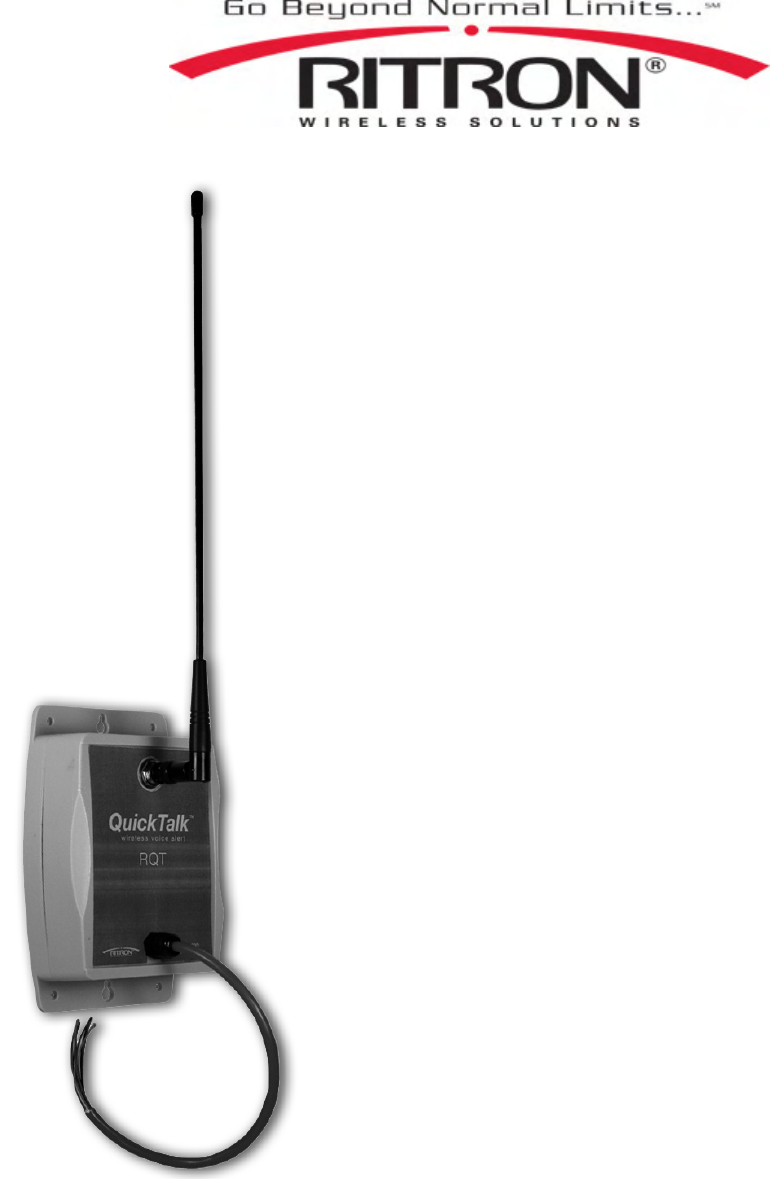
PRELIMINARY
Quick Talk
TM
Wireless Voice Monitor & Alarm
Owner’s Manual
•
C
ONSTRUCTION
•
F
ACTORIES
•
W
AREHOUSES
•
F
ARMS
•
U
TILITIES
•
A
IRPORTS
•
R
ETAIL
S
TORES
•
S
ECURITY
•
L
AW
E
NFORCEMENT
•
S
HIPPING
•
A
PARTMENTS
•
S
PORTS
•
H
OTELS
•
R
ESTAURANTS
•
S
CHOOLS
•
T
RANSPORTATION
______________________________________________________________________
Ritron Publication 145000081 Rev. A 12-10
© 2010 Ritron, Inc. All rights reserved. Ritron, Patriot, Jobcom, OutPost, GateGuard, Quiet Call and Quick Assist are registered
trademarks of Ritron, Inc. Quick Talk, Liberty and RadioNexus are trademarks of Ritron, Inc.
Call 800-USA-1-USA for the right Wireless Solutions to your communication needs.
P.O. Box 1998 • Carmel, Indiana 46082-1998 • USA
Phone: 317-846-1201; 800-USA-1-USA (800-972-1872) • Fax: 317-846-4978
Email: ritron@ritron.com
www.ritron.com

For assistance, call RITRON at 800-872-1872, or go to www.ritron.com 0
TABLE OF CONTENTS ...............................................................
Description Page
Accessories for Quick TalkTM ......................................................... ii
What this Manual Covers............................................................... ii
Important Safety information.......................................................... ii
About the Quick TalkTM Wireless Voice Monitor & Alarm
General information....................................................................1
Quick TalkTM Models and Frequencies.......................................1
Please Note the Following with Regard to RF Exposure for this
Product ..........................................................................................1
Quick TalkTM Wireless Voice Alarm Reporter Features
Basic Features ...........................................................................2
Advanced Features....................................................................2
Frequently Asked Questions about Quick TalkTM Programming ....2
Identification of Quick TalkTM Controls and Connectors.................2
FIG-1: Controls & Connectors...................................................2
Quick TalkTM Programming Features.............................................4
Description .................................................................................4
Frequency Table ........................................................................4
Transmit Frequency ...................................................................4
QC or DQC Code .......................................................................4
DQC Invert .................................................................................4
TX Alert Tone .............................................................................4
Compand....................................................................................5
Input Type ..................................................................................5
Input Operation ..........................................................................5
Message Repeat ........................................................................6
Quick TalkTM Default Programming............................................6
Programming Your Quick TalkTM Transmitter Frequency and Tone
.......................................................................................................7
Table 1: MURS model radios only..............................................7
Table 2: VHF Business band models ........................................7
Table 3: UHF Business band models........................................7
Table 4: Quiet Call Tone Codes .................................................8
Table 5: Digital Quiet Call Codes ..............................................8
Recording Your Quick TalkTM Voice Messages .............................9
Number of Inputs........................................................................9
Message Delay on TX................................................................9
Input Messages..........................................................................9
Low Battery Message.................................................................9
Power Fail Message...................................................................9
Location Message ......................................................................9
To Record Your Quick TalkTM Voice Messages: ........................9
Test Your Quick TalkTM Programming .........................................10
Installing the Quick TalkTM ...........................................................11
Care and Maintenance.................................................................11
Test Your Switch’s Open and Closed Condition ..........................12
Record Custom Voice Messages for Your Switch Conditions......12
Setting Battery Saver Options......................................................12
Automatic Low Battery Alert Message .........................................13
Connecting an External +12 VDC Power Supply.........................13
Solar Panels for Operating & Charging Rechargeable Batteries .13
Adding a 2nd Switch to Disable the Quick TalkTM Transmitter.....13
Monitor 4-20mA Sensor Current Loop with Quick TalkTM Analog
Input.............................................................................................14
Ritron, Inc. Limited Warranty .......................................................15
ACCESSORIES FOR QUICK TALKTM ............
These replacement and optional items are
available from Ritron and its authorized
dealers.
Item Description
AFB-1545 Standard 16 in. Flexible
Whip Antenna
RAM-1545 Magnetic-Mount Antenna wI
20 ft. of Cable and a BNC
Connector
WHAT THIS MANUAL COVERS ...................
This manual covers basic operation of the
Quick TalkTM Wireless Voice Monitor and
Alarm. For most applications, this is all the
information you will need. More complex
features of Quick TalkTM are explained in the
Advanced Features Section of this manual.
IMPORTANT SAFETY INFORMATION ............
NOTICE: The Quick TalkTM unit should not
be used to report conditions relating to safety
of life or property.
To reduce the risk of fire, electric shock or
personal injury, follow these basic safety
instructions when using this unit.
1. Read and follow all instructions.
2. Disconnect the unit before cleaning. Do
not use liquid or aerosol cleaners.
3. Use only approved power sources for
the unit.
4. During thunderstorms, avoid contact
with this unit and any external antenna
system or wiring.
5. The Quick TalkTM switch and external
power terminals are connected internally
to the antenna connector. If the Quick
TalkTM switch or power supply terminals
contact high voltage, a hazardous
condition may exist in that contacting
the antenna could prove injurious or
even fatal.
6. In general, the switches you connect to
the Quick TalkTM are to be independent
dry contact switches, and not part of any
other “live” electrical circuit
7. If you are unsure whether your
installation will be safe, contact an
experienced electrician or electronics
technician.
ii

For assistance, call RITRON at 800-872-1872, or go to www.ritron.com 1
ABOUT THE QUICK TALKTM WIRELESS VOICE MONITOR & ALARM.......................................................................
General Information
The Quick TaIkTM is a wireless radio transmitter that
reports changes in the status of switches by
transmitting user-recorded voice messages to two-way
mobile, portable or base station radios. Quick TalkTM
transmits your voice message when the switch change
occurs, and at intervals you select.
Because you provide and connect the switches, your
Quick TalkTM units can report on the status of intrusion,
tampering, equipment malfunction, liquid levels,
machinery, pressure, temperature, power, smoke or
leakage.
The Quick TalkTM is easily programmed to transmit on
either an existing or a new radio frequency, with the
most popular sub-audible coded squelch formats, such
as Quiet Call® or Digital Quiet CallTM. This enables all
your personnel with JOBCOM®, PATRIOT®, or
equivalent two- way radios to hear the voice messages
instantly, and to be advised of the current condition of
each monitored location or device.
Quick TalkTM is housed in a weather-resistant
enclosure, so it can be installed in a wide variety of
indoor and outdoor locations. Because it’s six internal
AA Alkaline batteries will power the unit for about a
year, Quick TalkTM does not require AC line power.
Quick TalkTM Models and Frequencies
There are two Quick TalkTM models, one for each of the
most popular professional radio communications bands.
The model number appears on a label on the front of
the case, and on a second label inside the case.
MODEL BAND FREQUENCY RANGE
RQT-151 VHF-FM 150 to 165 MHz
RQT-451 UHF-FM 450 to 470 MHz
Ritron manufactures mobile, portable and base station
two-way radios and repeaters for use with Quick TalkTM.
Ritron pioneered the use of Color Dots on radios to
identify frequencies.
Factory-programmed, default Quick TalkTM frequencies
are:
Red Dot = 151.625 MHz for VHF units;
Blue Star = 467.925 MHz for UHF units.
See page 4 for instructions on changing the Quick
TalkTM transmit frequency to match an existing radio
system.
PLEASE NOTE THE FOLLOWING WITH REGARD TO RF EXPOSURE FOR THIS PRODUCT .........................................
EXPOSURE TO RADIO FREQUENCY ENERGY:
RQA-151: This product generates radio frequency (RF)
energy when the button on the front of the unit is
depressed. This product has been evaluated for
compliance with the maximum permissible exposure
limits for RF energy at the maximum power rating of the
unit when using antennas available from RITRON.
RQT-151: This product generates radio frequency (RF)
energy when the state of any of the four inputs has
been changed. This product has been evaluated for
compliance with the maximum permissible exposure
limits for RF energy at the maximum power rating of the
unit when using antennas available from RITRON.
For both the AFB-1545 and the standard internal
antennas, at the 20 cm (7.9 inches) minimum expected
separation distance and greater, the maximum RF
exposure is well below the General
Population/Uncontrolled limits. Antennas other than
those available from RITRON have not been tested for
compliance and may or may not meet the exposure
limits at the distances given. Higher gain antennas are
capable of generating higher fields in the strongest part
of their field and would, therefore, require a greater
separation from the antenna. This product is not to be
used by the general public in an uncontrolled
environment unless compliance with the
Uncontrolled/General Population limits for RF exposure
can be assured.
To limit exposure to RF energy to levels below the limit,
please observe the following:
• Use only the antenna(s) available from RITRON for
these models. DO NOT operate the radio without
an antenna.
• DO NOT activate the transmitter when not actually
wishing to transmit. These radios transmit recorded
messages of a pre-determined length to prevent
continuous transmit times.
• When transmitting, make certain that the distance
limits for the particular model in use are observed.
• DO NOT allow children to operate the radio.
When used as directed, this series of radios is designed
to comply with the FCC’s RF exposure limits for
“Uncontrolled/General Population”. In addition, they are
designed to comply with the following Standards and
Guidelines:
• United States Federal Communications
Commission, Code of Federal Regulations; 47 CFR
§§ 2 sub-part J.
• American National Standards Institute (ANSI) /
Institute of Electrical and Electronic Engineers
(IEEE) C95. 1-1992.
• Institute of Electrical and Electronic Engineers
(IEEE) C95.1-1999 Edition.
Copyright Telecommunications Industry Association

For assistance, call RITRON at 800-872-1872, or go to www.ritron.com 2
QUICK TALKTM WIRELESS VOICE ALARM REPORTER FEATURES .........................................................................
Basic Features:
• Internal radio transmitter (separate VHF and UHF
models).
• User-recorded voice messages; total recording time of
30 seconds.
• Connection to user-supplied switches.
• Included external antenna.
• Typical range of 1/2 mile. Longer range is possible
using an optional antenna.
• Weather-resistant (not waterproof nor immersible)
enclosure.
• Internal battery holder for six (6) AA Alkaline cells.
• Companded Audio – Selectable.
• External 12 VDC power supply with battery back-up.
• Connection and use of an external 12 Volt DC power
supply.
• Typical operating battery life of 1 year.
• Automatic low battery message.
• Limited One-year Factory Warranty.
• The following programmable features:
- Transmit Frequency;
- Tone Coded Squelch Encoder (Quiet Call®
Interference Eliminator);
- Digital Coded Squelch Encoder (Digital Quiet
CaIITM Interference Eliminator);
- Message transmission schedules and limits.
Advanced Features:
• Use of multiple (4) switch inputs for messages
• Analog voltage (or 4-20 mA loop) inputs
• Multiple location identification messages
• Terminated alarm loop inputs
• Use of solar power panels to operate and
charge internal NiCad batteries
• Enabling and disabling the low battery or
external power failure messages
• Battery saver options
FREQUENTLY ASKED QUESTIONS ABOUT QUICK TALKTM PROGRAMMING............................................................
Do I have to program my Quick TalkTM?
You may not need to program your Quick TalkTM at
all. If you purchased a Quick TalkTM that is factory-
programmed to your radio system frequency (check
the Color Dots on your radios and the Quick TalkTM),
and you do not use a form of Quiet Call coded
squelch, you can connect your switch to the color-
coded “Switch #1” wires on the hook-up cable, install
the batteries, and start using Quick TalkTM. The
factory default voice messages are “Switch Open”
and “Switch Closed”. Otherwise, read this manual,
and then program your Quick TalkTM.
Do I need to program every feature?
In many cases, no. The factory pre-programmed
settings, explained in the instructions, may meet
many of your needs.
How do I program my Quick TalkTM?
Quick TalkTM is programmed using RITRON
programming software and a PC computer.
What if I don’t find what I need in this
manual?
Call Ritron; we will be glad to help you. For most
applications, this manual should cover everything you
will need to know. However, the Quick TalkTM has
more capabilities and features than described here.
Contact us at Ritron; we can make Quick TalkTM do
just about anything.
Will it harm the Quick TalkTM if I program it
improperly?
No; however, you may need to erase all programming
and start over; see page 10 to do this. Feel free to
experiment with the various features and possible
configurations.
Can my settings or messages get lost or erased
if the battery runs down, or if my Quick TalkTM is
disconnected?
No. The settings and voice messages you enter are
stored in special electronic memory devices in the Quick
TalkTM that do not require power to hold the information.
This means that if the batteries run down or if you remove
them, you will not need to reprogram the unit. All your
settings and messages will be there for you when you
install fresh batteries.
What if I need more range?
To increase the range of your Quick TalkTM
transmissions, we suggest you first relocate the unit.
Depending on the type of switch and wiring, you may use
several hundred feet of wiring to connect the switch —
this allows installation of the Quick TalkTM and its
attached antenna for the best range, at an unobstructed
and elevated position.
Also, Ritron offers several optional “high gain” antennas.
And, Ritron can provide a radio repeater to increase the
range not only for your Quick TalkTM, but also for your
entire radio system.

For assistance, call RITRON at 800-872-1872, or go to www.ritron.com 3
1
2
3
4
5
6
8
9 10
11
7
IDENTIFICATION OF QUICK TALKTM CONTROLS AND CONNECTIONS .....................................................................
1 Battery Holder
The battery holder accommodates the six (6)
standard “AA” alkaline cells required to power the
Quick TalkTM.
NOTE: Always install a fresh set of alkaline
batteries before programming the unit.
2 BNC Antenna Connector
The antenna radiates radio signals. Before using
Quick TalkTM, make sure the antenna is fastened
securely to this connector on the front of the radio.
3 SMB Antenna Connector
This connects the front-panel, BNC antenna
connector to the radio printed circuit board.
4 External Audio Input
Allows input to the Quick TalkTM voice recorder
from an external audio source, such as the Line
Out audio from your computer.
5 Microphone
Microphone for recording voice messages.
6 USB Programming Connector
Connects the Quick TalkTM to the USB port on
your computer for programming.
FIG-1: CONTROLS & CONNECTIONS
7 Record Button
Press this button to initiate voice recording.
8 External Hook-up Cable
A 10-conductor cable for connection of external power supply
and up to four (4) switch inputs.
9 Watertight Strain Relief Cable Fitting
The cable to your external switches passes through this
fitting. When the strain relief fitting is used with
recommended cable sizes, it provides a water- resistant
enclosure. Do not overtighten this fitting.
NOTES: Use Radio Shack Telephone Station Wire, 6-
conductor, solid 24-AWG In-wall Type CM, Cat. No. 278-874,
or equivalent size round cable (0.114 — 0.250” diameter).
If you cannot find suitable wire, call Ritron at 800-872-1872.
10 External Hook-up Connector
A 10-position connector for the external hookup cable.
11 Battery Connector
In-line connector between the printed circuit board and the
battery holder.
IMPORTANT: Do not remove any other fasteners or further
disassemble the Quick TalkTM unit; doing so risks damage to
the unit and voiding the manufacturer’s warranty.

For assistance, call RITRON at 800-872-1872, or go to www.ritron.com 4
QUICK TALKTM PROGRAMMABLE FEATURES ......................................................................................................
The Quick TalkTM features four (4) separate inputs that can each be
programmed with unique voice messages and attributes. All
programming is accomplished with the RITRON RQA/RQT PC
Programmer software available at www.ritron.com.
The programmer software requires Window® XP or greater, and a PC
computer with a USB port.
Description
Enter a brief description (35 characters or less) of the Input function or
the recorded message. This can be useful when reading out the Quick
TalkTM programming at a later date, or when saving a programming
profile for use with other radios.
Frequency Table #
To match other RITRON radios, the owner can select from a table of
transmit frequencies. Simply “read-out” the Frequency Code of your
RITRON portable, mobile or base radio and enter the same code when
programming the Quick TalkTM.
Transmit Frequency
Once you have selected a Frequency Code the actually transmit
frequency will appear here. If your operating frequency does not appear
on the Frequency Code list, a licensed radio service technician will be
able enter other frequencies within the radio’s operating band.
To identify your assigned frequency:
• Read-out the Frequency Code of the RITRON radio you intend to
use with the Quick TalkTM.
• Check for a corresponding color dot on the radio you intend to use
with the Quick TalkTM.
• Locate a label identifying the receiver frequency in megahertz
(MHz).
• Your assigned frequency is shown on your F.C.C. Station License.
• Call your radio dealer or Ritron for help if you cannot determine your
radio’s receiver frequency.
The original factory-programmed
transmitter frequency of your Quick
TalkTM is marked on the outside of the
shipping box.
QC or DQC Code
Select from a list of QC and DQC
Codes to transmit subaudible squelch
tones for interference elimination.
The Quick TalkTM radio transmitter is
compatible with two standard
communications industry sub-audible
signaling formats: QC (Quiet Call®
Interference Eliminator), and DQC
(Digital Quiet CallTM Interference
Eliminator). Both Quiet Call formats
unlock receivers programmed to
require these codes -- they screen out
interference from other radio systems
operating on your same transmit
frequency.
QC Quiet Call® is Ritron’s trade name
for what the communications industry
calls sub-audible (below the range of
human hearing) tone squelch, or
CTCSS (Continuous Tone Coded
Subaudible Squelch). Other radio
manufacturers use different trade-
names for essentially the same system.
You may program a specific QC code
into your Quick TalkTM to transmit with
the voice messages, which will “unlock”
the receivers in your radio system.
DQC Digital Quiet CallTM is Ritron’s
digital coded squelch, and works the
same as QC, except it is a digital code
that is transmitted with the voice
messages.
To identify your QC or DQC tone:
• Read-out the Tone Code of the
RITRON radio you intend to use
with the Quick TalkTM.
• Refer to your radio manual.
• Contact your radio dealer or Ritron
if you are unsure about this issue.
DQC Invert
The DQC Digital Quiet CallTM code can
be inverted for systems that required
inversion.
TX Alert Tone
The RQT can transmit an alert tone
before and after each voice message
transmission.
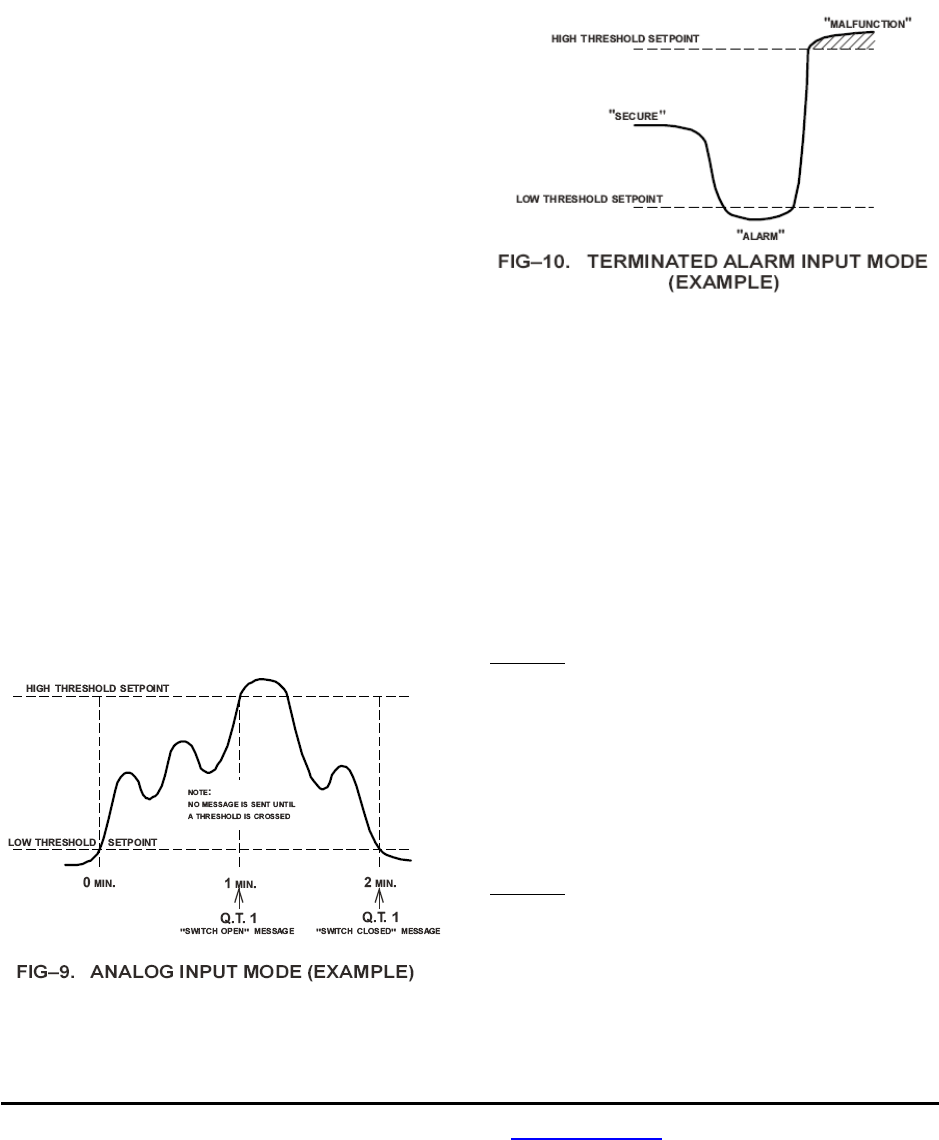
For assistance, call RITRON at 800-872-1872, or go to www.ritron.com 5
Compand
Some two-way radios have a feature referred to as
“companding”. It is a way of eliminating background
hiss or noise, making the radio sound clearer.
“Companding” is a combination of audio “compression”
in the transmitter and audio “expanding” in the receiver.
The Quick TalkTM can be programmed for audio
compression. To determine if your existing 2-way radios
are using the Companding feature, you can check the
radio’s User Manual, contact your radio dealer, or call
Ritron for help.
If you are unable to determine if your portable radio
uses the companding feature, we suggest the following:
1. Leave the radio in the factory default setting with
no companding.
2. Activate the transmitter of the Quick TalkTM and
listen to the message from your portable radio. If
the received audio is acceptable, you should not
need to set the Quick TalkTM for companding.
Input Type
Each input can be programmed for one of the three (3)
basic types of Input operation.
Contact Closure – Is used when a switch closure is
connected to the input.
Analog Input – Voltages above the High Threshold
Setpoint cause the Input OPEN message to transmit.
Voltages below the Low Threshold Setpoint cause the
Input CLOSED message to transmit. The dead zone—
an area of hysteresis provided by the difference
between High and Low Threshold Setpoints—prevents
unwanted messages caused by noise or minor signal
changes. See Fig—9.
When the input is in CLOSED condition, a change to
OPEN condition occurs only when the signal exceeds
the High Threshold Setpoint. Similarly, when the input is
in OPEN condition, the change to CLOSED condition
occurs only when the signal is less than the Low
Threshold Setpoint.
Terminated Alarm Input - This mode is useful in
security alarm applications, where the “Secure” (Good)
condition is a range of voltages. Any voltage above or
below this range represents an “Alarm” (Bad) condition.
See Fig—10.
The “Secure” condition is the range of voltage between
the High and Low Threshold Setpoints. The Input
OPEN message is activated in this range. Voltage
above High Threshold Setpoint, or below Low
Threshold Setpoint activates the Input CLOSED
message.
Analog Setpoints - The HIGH and LOW Threshold
Setpoints used when the Input is set to Analog Input
mode or Terminated Alarm Input mode can be
programmed to any DC voltage between 0-5 VDC. The
Analog Setpoints have no effect when the Input is set
Contact Closure mode.
Input Operation
Normal – operation transmits a message each time a
changed condition is detected.
Debounce Mode - is an option specifying that the
switch must remain in its changed condition for the
programmed debounce time before generating a
message for the changed condition.
Example: A sensor is used to detect a car in a “No
Parking” zone. Since it is undesirable for a message to
be generated by normal traffic through the “No Parking”
zone, a five-minute Debounce is used. Only if the
sensor is activated for a full five minutes will the “car
illegally parked” message be transmitted.
Holdoff Mode - option transmits messages immediately
upon a change of switch condition, and will hold off a
message indicating further change for the programmed
holdoff time.
Example: A Quick TalkTM is used as a gate doorbell. It
is practical for the message to be transmitted
immediately, and also desirable to have a one-minute
holdoff before the same message is re-sent, even if the
button is pushed repeatedly.
Debounce / Holdoff Time – specifies the debounce
time or holdoff time described above. This time is
programmed independently for the OPEN and CLOSED
conditions.

For assistance, call RITRON at 800-872-1872, or go to www.ritron.com 6
Latching Input Mode - Use the Quick TalkTM Latching
Input mode if repeated transmissions are desired with a
momentary switch (i.e. a push-button). The latching
effect maintains message repeats after the momentary
switch change has ended.
Example: To use a Quick TalkTM in a paint department,
you want it to re-transmit a message several times after
a “Press for Help” push-button is pressed. With the
Quick TalkTM set to Latching Input mode, release of the
push-button is ignored and the message is re-
transmitted as scheduled.
Message Repeat
Repeat Message on each transmission
Your recorded voice message can be programmed to
repeat from one time to nine times on each Quick
TalkTM radio transmission, depending on how you
program this feature. More urgent messages may have
more phrase repeats.
Example: You recorded the message “Pump Motor
Hot”, then programmed Quick TalkTM to repeat the
phrase two (2) times in each transmission. In this case,
activating the switch results in the Quick TalkTM
transmitting:
“...beep. Pump motor hot. Pump motor hot. beep...” The
beginning and ending beeps are added automatically to
attract attention to Quick TalkTM transmissions.
Repeat Message with multiple transmissions
You can set a limit to the number of times the message
will be transmitted at the scheduled intervals.
Example: Suppose you have a vehicle detector switch
that closes when it detects a vehicle at the delivery door
of your building. Your recorded message might then be
“Vehicle at Delivery Door”. You may want this message
to be transmitted every two minutes for approximately a
quarter hour after a vehicle is detected, then to stop
transmitting until the vehicle is moved. In this case, you
would program the message Wait Time for every two
minutes, and set the Message Limit to “8”, as described
here.
When a vehicle arrives, the switch closes and the
message is transmitted every 2 minutes until it has
been sent 8 times over a span of 16 minutes, unless the
vehicle leaves before 16 minutes has lapsed. In this
case, the switch opens and the message ceases when
the vehicle is moved.
When another vehicle arrives, the Quick TalkTM again
transmits the message every two minutes for about a
quarter of an hour, or until the vehicle leaves.
The Quick TalkTM is set at the factory to transmit switch
status messages without limit. For example, if you
programmed the Quick TalkTM to transmit a status
message every hour, it would continue to do so until the
battery runs down.
Wait time between repeated transmissions
This sets the amount of time the Quick TalkTM will wait
between repeated transmissions. You can program a
different Wait Time for the open condition, and for the
closed condition of your switch.
Example: The switch status message for switch open is
“Pump motor temperature OK”. You may schedule the
Quick TalkTM to transmit this message once every two
hours; this way, you know the Quick TalkTM is operating
properly.
If the corresponding switch status message for switch
closed is “Pump Motor Over Temperature”, you may
schedule the Quick TalkTM to broadcast this message
every two minutes, so the situation would receive
prompt attention.
QUICK TALKTM DEFAULT PROGRAMMING ...........................................................................................................
TX Frequency (all inputs) 24 151.625 MHz (VHF)
26 467.850 MHz (UHF)
QC/DQC Code (all inputs) 44 No Tone
DQC Invert No
Compand No
Input Type Contact Closure
Analog Setpoints High 3.5 VDC
Low 1.7 VDC
Input Operation Normal
Latching Input Mode No
Debounce/Holdoff Time Open/High 10 sec.
Closed/Low 10 sec.
Number of Inputs Inputs 1-2
TX Alert Tone Yes
Battery Saver Yes
Low Battery Message Yes
Power Fail Message No
Message Delay on TX 1 sec.
Recorded Messages
Input 1 Open/High “Switch 1 open”
Input 1 Closed/Low “Switch 1 closed”
Input 2 Open/High “Switch 2 open”
Input 2 Closed/Low “Switch 2 closed”
Power Fail “Power fail”
Low Battery “Low battery”
Number of Times Recorded Message is repeated on
each Transmission
Inputs 1-4 Open/High One time
Inputs 1-4 Closed/Low One time
Number of Times the Transmission is sent
Inputs 1-4 Open/High Repeat forever
Inputs 1-4 Closed/Low Repeat forever
Wait Time between Transmissions
Inputs 1-4 Open/High On change only
Inputs 1-4 Closed/Low On change only
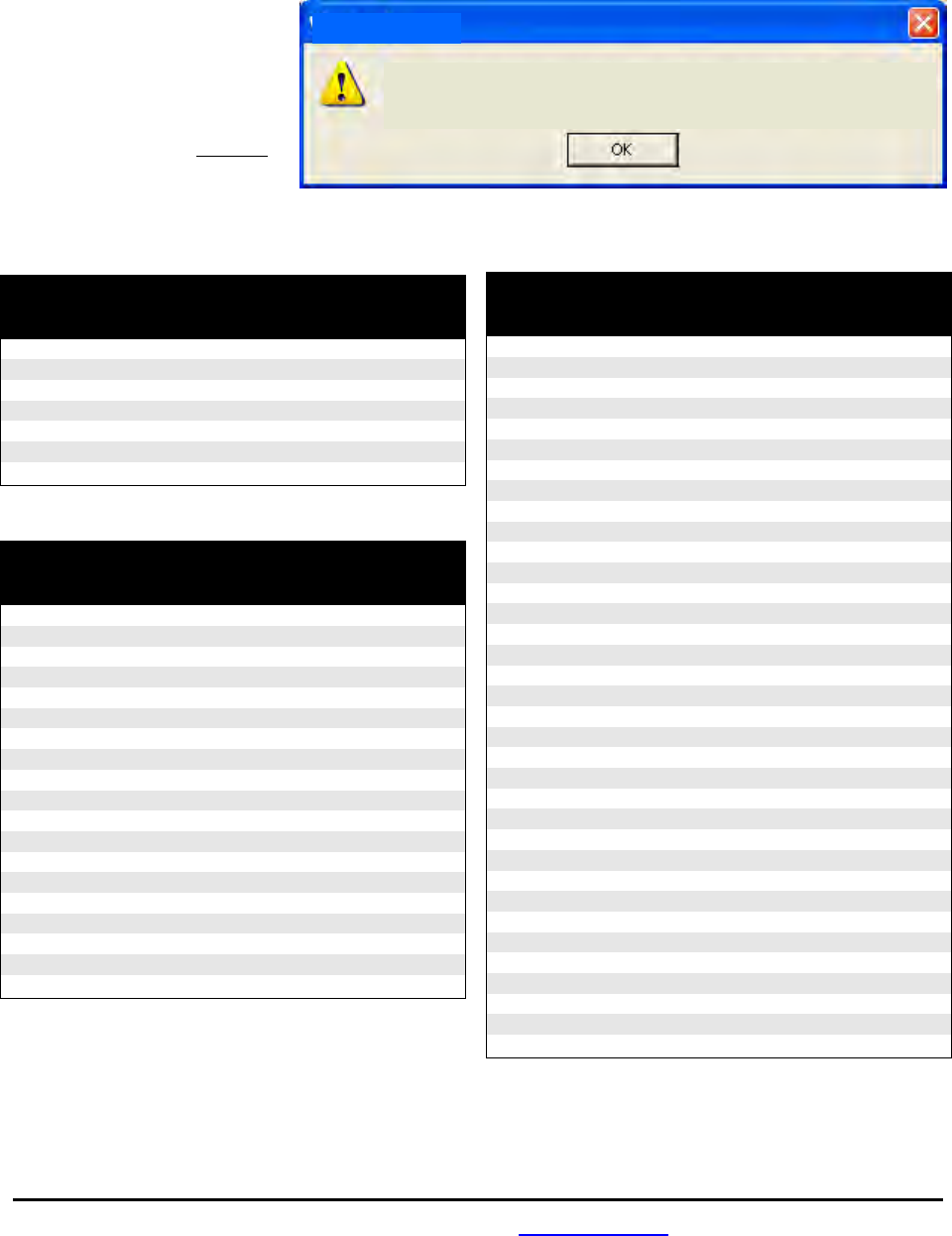
For assistance, call RITRON at 800-872-1872, or go to www.ritron.com 7
PROGRAMMING YOUR QUICK TALKTM TRANSMITTER FREQUENCY AND TONE.......................................................
The Quick TalkTM transmitter operates exclusively on a 12.5 kHz narrow band channel bandwidth. Many of the
Frequency Table Codes programmed in your compatible Ritron radios are for 25 kHz wide band channels. If these
codes are selected when programming your Quick TalkTM radio, the programmer will automatically update to the
equivalent 12.5 kHz code. This allows you to use your Quick TalkTM with all of your existing radios. The following
dialog box will appear any time you attempt to program a wideband code into a Quick TalkTM.
MURS model radios can only be
programmed to the codes listed
on Table 1 below. VHF Business
band models can be programmed
to the codes listed on Table 2
below, or can be programmed to
any valid licensed frequency
between 150-165 MHz EXCEPT
the frequencies listed on MURS
Table 1 below.
TABLE 1: MURS model radios only
Narrow Band
Frequency Equivalent
Code (MHz) Color Dot Code
01 154.600 Green Dot 22
02 154.570 Blue Dot 23
19 151.820 MURS
20 151.880 MURS
21 151.940 MURS
22 154.600 MURS
23 154.570 MURS
TABLE 2: VHF Business band models
Narrow Band
Frequency Equivalent
Code (MHz) Color Dot Code
03 151.625 Red Dot 03N *
04 151.955 Purple Dot 04N *
05 151.925 05N *
06 154.540 06N *
07 154.515 07N *
08 154.655 08N *
09 151.685 09N *
10 151.715 10N *
11 151.775 11N *
12 151.805 12N *
13 151.835 13N *
14 151.895 14N *
15 154.490 15N *
16 151.655 16N *
17 151.745 17N *
18 151.865 18N *
24 154.700
25 151.760
26 152.700
* New Narrow Band Table Frequency
TABLE 3: UHF Business band models
Narrow Band
Frequency Equivalent
Code (MHz) Color Dot Code
01 467.7625 J 24
02 467.8125 K 25
03 464.5500 Yellow Dot 23
04 464.5000 Brown Dot 22
05 467.8500 Silver Star 26
06 467.8750 Gold Star 27
07 467.9000 Red Star 28
08 467.9250 Blue Star 29
09 469.2625 09N *
10 462.5750 White Dot 10N *
11 462.6250 Black Dot 11N *
12 462.6750 Orange Dot 12N *
13 464.3250 13N *
14 464.8250 14N *
15 469.5000 15N *
16 469.5500 16N *
17 463.2625 17N *
18 464.9125 18N *
19 464.6000 19N *
20 464.7000 20N *
21 462.7250 21N *
22 464.5000
23 464.5500
24 467.7625
25 467.8125
26 467.8500
27 467.8750
28 467.9000
29 467.9250
30 461.0375
31 461.0625
32 461.0875
33 461.1125
34 461.1375
35 461.1625
The frequency code you have selected is for 25 kHz wideband operation.
The Quick Talk radio operates on 12.5 kHz narrow band only. Your
frequency code will be automatically updated to a narrow band equivalent.
IMPORTANT!

For assistance, call RITRON at 800-872-1872, or go to www.ritron.com 8
TABLE 3: UHF Business band models (cont.)
Narrow Band
Frequency Equivalent
Code (MHz) Color Dot Code
36 461.1875
37 461.2125
38 461.2375
39 461.2625
40 461.2875
41 461.3125
42 461.3375
43 461.3625
44 462.7625
45 462.7875
46 462.8125
47 462.8375
48 462.8625
49 462.8875
50 462.9125
51 464.4875
52 464.5125
53 464.5375
54 464.5625
55 466.0375
56 466.0625
Narrow Band
Frequency Equivalent
Code (MHz) Color Dot Code
57 466.0875
58 466.1125
59 466.1375
60 466.1625
61 466.1875
62 466.2125
63 466.2375
64 466.2625
65 466.2875
66 466.3125
67 466.3375
68 466.3625
69 467.7875
70 467.8375
71 467.8625
72 467.8875
73 467.9125
74 469.4875
75 469.5125
76 469.5375
77 469.5625
TABLE 4: Quiet Call Tone Codes
Code Frequency
01 67.0
02 71.9
03 74.4
04 77.0
05 79.7
06 82.5
07 85.4
08 88.5
09 91.5
10 94.8
11 97.4
12 100.0
13 103.5
Code Frequency
14 107.2
15 110.9
16 114.8
17 118.8
18 123.0
19 127.3
20 131.8
21 136.5
22 141.3
23 146.2
24 151.4
25 156.7
26 162.2
Code Frequency
27 167.9
28 173.8
29 179.9
30 186.2
31 192.8
32 203.5
33 210.7
34 218.1
35 225.7
36 233.6
37 241.8
38 250.3
39 69.4
Code Frequency
40 159.8
41 165.5
42 171.3
43 177.3
44 No Tone
45 183.5
46 189.9
47 196.6
48 199.5
49 206.5
50 229.1
51 254.1
Use Code “44” to program No Tone for systems without a Coded Squelch Interference Eliminator feature.
TABLE 5: Digital Quiet Call Codes
Code
023
025
026
031
032
036
043
047
051
053
054
065
Code
071
072
073
074
114
115
116
122
125
131
132
134
Code
143
145
152
155
156
162
165
172
174
205
212
223
Code
225
226
243
244
245
246
251
252
255
261
263
265
Code
266
271
274
306
311
315
325
331
332
343
346
351
Code
356
364
365
371
411
412
413
423
431
432
445
446
Code
452
454
455
462
464
465
466
503
506
516
523
532
Code
546
565
606
662
612
624
627
631
632
645
654
664
Code
703
712
723
731
732
734
743
754
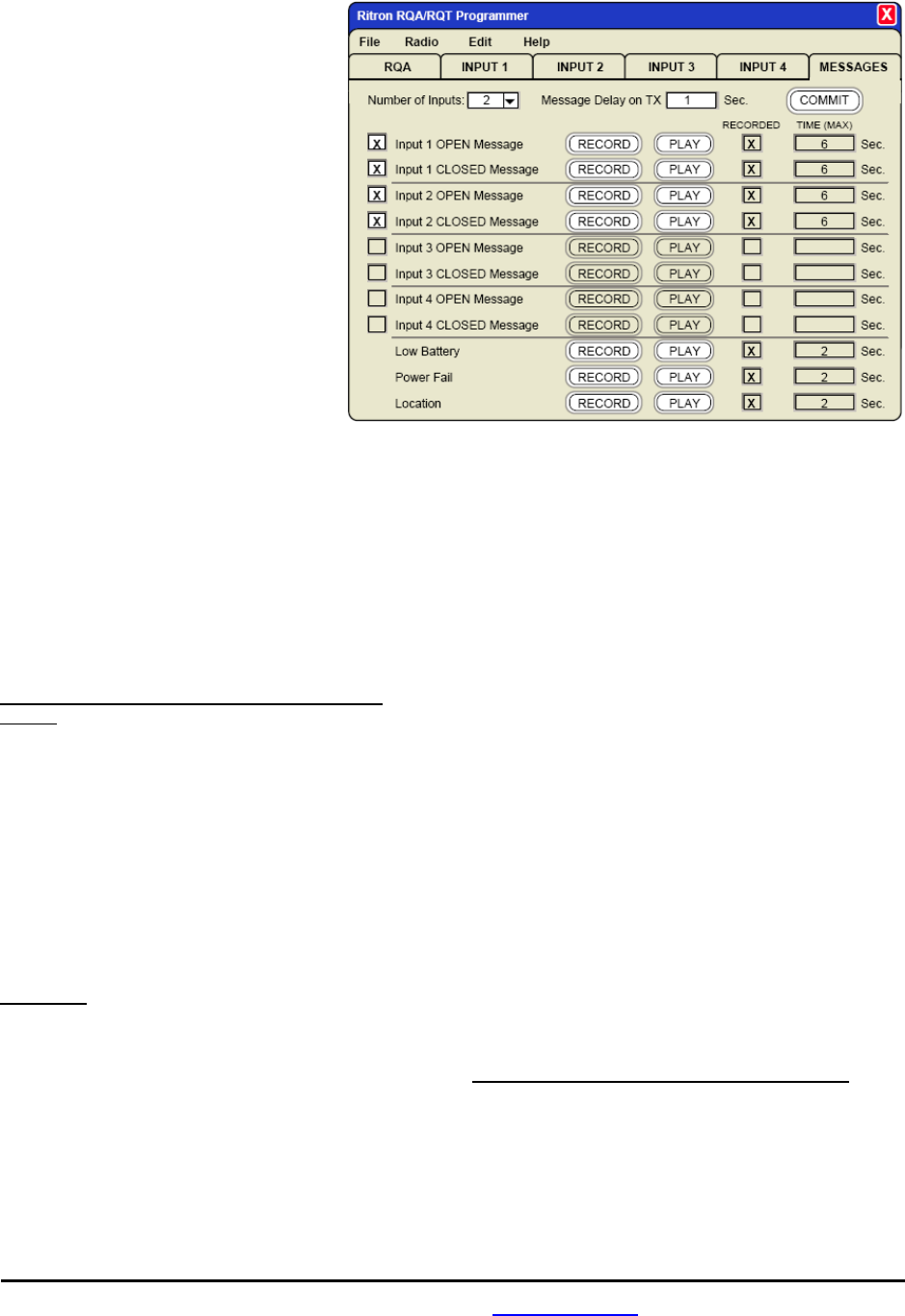
For assistance, call RITRON at 800-872-1872, or go to www.ritron.com 9
RECORDING YOUR QUICK TALKTM VOICE MESSAGES .........................................................................................
Each of the four Quick TalkTM inputs
can be programmed to play two unique
voice messages, a “Switch Open”
message that plays when the input
changes to an OPEN or HIGH
condition, and a “Switch Closed”
message that plays when the input
changes to a CLOSED or LOW
condition.
Voice messages can be recorded into
the Quick TalkTM using the RQA/RQT
PC Programmer and the electret
condenser microphone built onto the
radio PCB assembly. Voice messages
can also be recorded with an incoming
audio signal from you computer. This
allows you to record and store a
message onto your computer and use it
for multiple Quick TalkTM transmitters.
Number of Inputs
Set the number of RQT inputs that will be used.
Message Delay on TX
Whenever the RQT transmitter is activated it will wait
this length of time before the alert tones and recorded
voice message are sent.
Input Messages
The length of each message is determined by two
factors:
1. The number of inputs to be used.
2. If you will play both an OPEN and CLOSED
message, or just one or the other.
A total of 24 seconds is allocated for all voice messages
related to the four inputs. The 24 seconds is first
divided equally by the number of inputs you have
programmed into your Quick TalkTM. Each input is then
divided by the number of messages it will play, either
two messages for both the OPEN and CLOSED
condition or one message if only one condition is
required.
EXAMPLE: If you have programmed your Quick TalkTM
for two inputs, 12 seconds will be allocated to each
input. If Input 1 transmits both the “Switch Open” and
“Switch Closed” messages they will each be limited to 6
seconds. If Input 2 requires only the “Switch Closed”
message it can be up to 12 seconds.
Carefully consider your requirements before recording
the Quick TalkTM voice messages. If you decide later to
use additional inputs, all messages will have to be re-
recorded.
Low Battery Message
When it senses the installed batteries are nearly run
down, Quick TalkTM will transmit one time each hour the
factory-programmed message: “Low Battery”. If you
maintain several Quick TalkTM transmitters within radio
range of each other, you may customize this feature to
easily determine which unit needs new batteries.
If you use only one Quick TalkTM in any area, or if you
regularly change Quick TalkTM batteries, the factory-
programmed message may be sufficient for your
application.
Power Fail Message
When the Quick TalkTM is powered with an external
+12VDC supply and batteries are installed as a back-
up, the RQT will transmit the Power Fail Message on a
scheduled basis as long as the +12VDC external supply
is not detected.
Location Message
When installing more than one Quick TalkTM on a single
frequency it may be desirable to record a unique
Location Message to identify each individual Quick
TalkTM. The Location Message will be played after the
TX Alert Tone and before the Input Message.
To record your Quick TalkTM Voice Messages:
1. Read existing radio programming.
2. Enter the Number of Inputs you will be using.
3. Select the messages you will be recording.
4. Enter Message Delay on TX time.
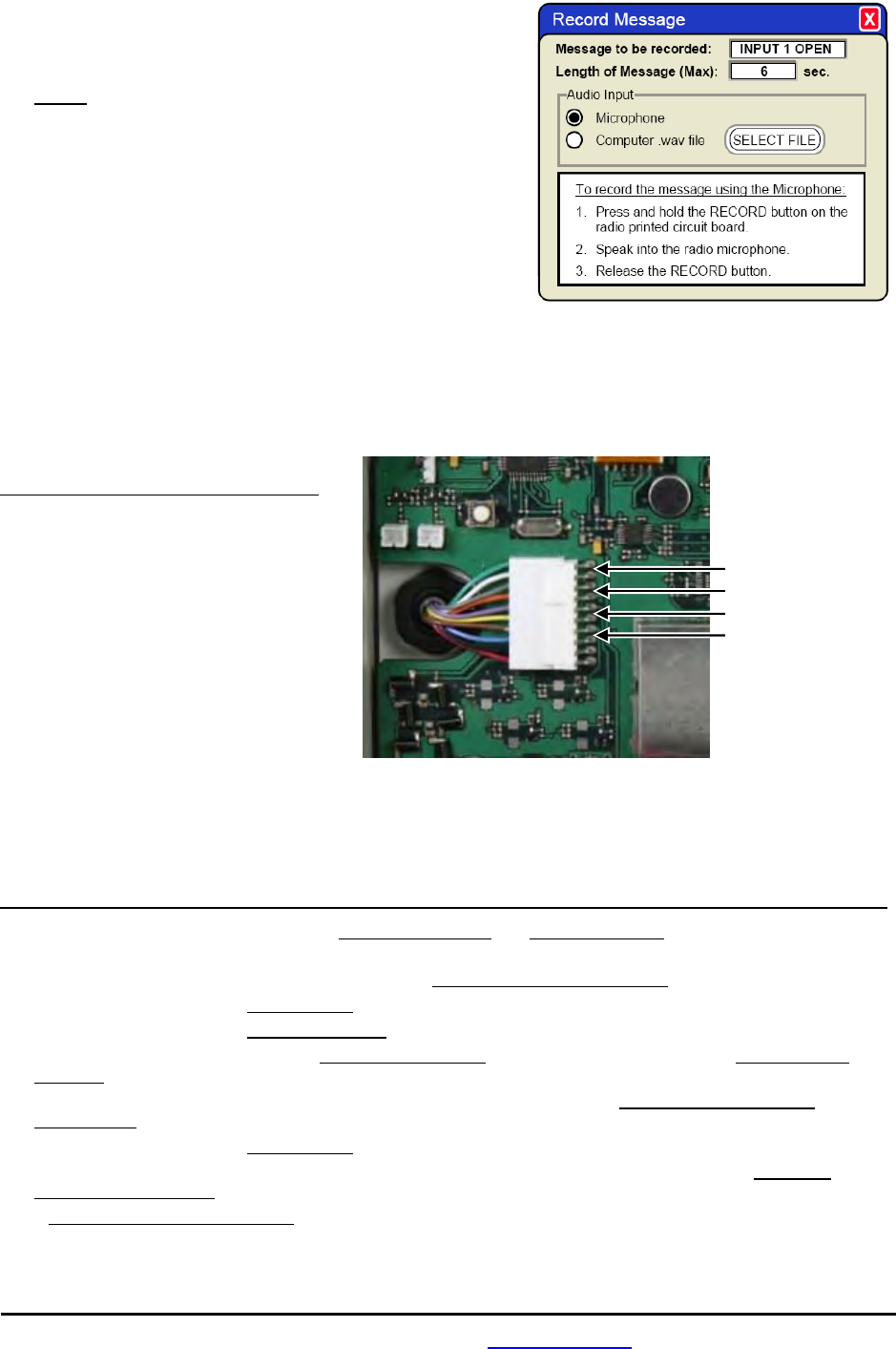
For assistance, call RITRON at 800-872-1872, or go to www.ritron.com 10
5. If there were any changes made during steps 2 through 4,
press the COMMIT button. This will erase all input messages,
they will have to be re-recorded and the RECORDED boxes will
no longer be checked.
NOTE: Pressing COMMIT button will not erase the Low Battery,
Power Fail, or Location messages.
6. To record a new message, press the associated RECORD
button and follow the instructions on the Record Message
dialog box.
7. The RECORDED checkbox will now indicate that the message
is recorded.
After you have recorded the message you can review by pressing
the associated PLAY button. The RQT will transmit the message on
the transmit frequency associated with the input selected.
TEST YOUR QUICK TALKTM PROGRAMMING........................................................................................................
Once your Quick TalkTM has been programmed it will transmit on the same frequency as your radio receivers, and will
transmit any coded squelch signals required for your radio system. Before installing the Quick TalkTM you should
test for communication with your radio
receivers.
To test the Quick TalkTM radio transmitter:
1 Attach the Quick TalkTM flexible
antenna.
2. Turn on your radio receiver.
3. Place a screwdriver, paper clip or other
electrically conductive item across the
Input #1 pins.
4. Quick TalkTM will transmit the Input 1
CLOSED messages, which you should
be able to hear on your radio receiver.
5. Remove the short across the Input #1
pins.
6. Quick TalkTM will transmit the Input 1
OPEN messages, which you should be able to hear on your radio receiver.
7. Repeat Steps 3 through 6 for Inputs 2, 3 and 4 if they have been programmed to be used.
8. If you do not hear the messages, you have probably not properly programmed the Quick TalkTM transmitter
frequency or the Quiet Call® Coded Squelch. In this case, repeat the programming and perform this test again.
Depending upon your programming, the following sequence describes what you should hear with your radio receiver:
1. The RQT transmitter is activated on the Transmit Frequency and QC or DQC Code programmed for the input
that has been activated.
2. The RQT will broadcast silence for the programmed Message Delay on TX Time
3. The RQT will broadcast the TX Alert Tone if it has been programmed.
4. The RQT will broadcast the Location Message if it has been recorded.
5. The RQT will broadcast the recorded Input OPEN Message if the input has gone high or the Input CLOSED
Message if the input has gone low.
6. The Input Message will be repeated for the number of times programmed for Repeat Message on each
Transmission.
7. The RQT will broadcast the TX Alert Tone again to signal the end of message, if it has been programmed.
8. The RQT transmitter will turn OFF and the RQT will wait for the period of time programmed for Wait Time
between Transmissions.
9. If Repeat Message Transmissions has been programmed for more than one transmission, the RQT transmitter
will again be activated and Steps 1 – 8 will be repeated for the programmed number of transmissions.
Input #1 (pins 9 &10)
Input #2 (pins 7 & 8)
Input #3 (pins 5 & 6)
Input #4 (pins 3 & 4)

For assistance, call RITRON at 800-872-1872, or go to www.ritron.com 11
INSTALLING THE QUICK TALKTM .........................................................................................................................
Prior to installing the Quick TalkTM transmitter, it is important to verify all radio programming to be certain that you
have achieved the operation you desire. Re-programming requires the removal of the Quick TalkTM from its installed
location, which can be time consuming and frustrating.
1. Install 6 new AA Alkaline batteries into the
internal battery holder and screw the case halves
together. Be sure the case halves are pulled tightly
together for a good weather seal.
2. Select a location that provides the best possible
radio coverage.
• Avoid mounting to metal structures
• Install as high as possible
• Be sure the antenna is in a vertical position
• Be aware that metal or wires near the antenna
can block or absorb radio transmissions.
3. Temporarily mount the Quick TalkTM using the
top keyhole slots.
4. Test the radio from this location to be sure you
get the necessary radio coverage. This is
achieved by activating the transmitter with a change
on one of the inputs while a second radio-equipped
person receives the transmission at the furthest point
you will need to cover.
5. Permanently mount the Quick TalkTM using either
the four (4) corner mounts, or the top and bottom
keyhole slots.
6. Connect the antenna to the
front panel BNC connector.
If the Quick TalkTM is installed
in an outdoor location, the
antenna connection must be
sealed with weather-proof
tape to prevent corrosion and
leakage. Seal the antenna
connection to hold the
antenna in a vertical position,
to protect antenna fittings, and
to maintain water-resistance
of the Quick TalkTM in wet or
outdoor environments. Use
Archer Connector Sealant,
Radio Shack Catalog Number
278-1645 or an equivalent.
Wrap the connection with the
sealant tape and press it
securely in place. See sealant
instructions for the specific
details.
7. Connect the 4 Inputs and External
+12VDC power provided by a 10-
conductor, color -coded cable from
the front of the Quick TalkTM. This
cable has been pre-installed with a
sealed strain relief to provide weather
resistance.
8. Connect your switches or sensors to the
desired Quick TalkTM input using wire
nuts to the color-coded cable described in
Table 6. Be sure to use an appropriate
sized, sealing wire nut. The color-coded
wires are 24 AWG stranded.
9. Test each one of the input switches or
sensors for the desired operation.
Table 6: Color-Coded Inputs
Input 1 + GREEN
- WHITE (Ground)
Input 2 + GRAY
- ORANGE (Ground)
Input 3 + PURPLE
- YELLOW (Ground)
Input 4 + BROWN
- BLUE (Ground)
External +12 VDC
+ RED
- BLACK
CARE AND MAINTENANCE...............................
Moisture: When the antenna sealant and power
cable recommendations are followed, the Quick
TalkTM is highly weather- resistant in outdoor
environments. Do not immerse the unit in water.
Temperature: The Quick TalkTM is designed to
operate between -22 and +140 degrees
Fahrenheit. Like all electronic equipment, Quick
TalkTM should not be subjected to extreme heat.
A shaded area is an ideal outdoor location.
VibrationslShocks: Though the Quick TalkTM is
designed to be rugged, it cannot be expected to
survive extreme abuse.
Chemicals: Do not use harsh, corrosive
or abrasive chemicals to clean the Quick
TalkTM case; use only a cloth moistened
with water. Do not attempt to clean the
printed circuit board inside the housing.
Batteries: Use only fresh, new alkaline
batteries when programming Quick
TalkTM. Acceptable brands and types
are: Duracell MX1500B, Eveready E91,
Rayovac 815 or equivalent.
Estimated Battery Life: Starting with a fresh set
of AA alkaline batteries, Quick Talk TM can
transmit about 7,000 voice messages over a
period of one year before the batteries will need
to be replaced.

For assistance, call RITRON at 800-872-1872, or go to www.ritron.com 12
TEST YOUR SWITCH’S OPEN AND CLOSED CONDITIONS......................................................................................
In the Quick TalkTM basic operating mode, you will record two (2) voice messages for the Quick TalkTM to transmit.
One message is transmitted when the switch is OPEN and the other is transmitted when the switch is CLOSED.
Before you record these switch condition messages, determine how your switch works by using the factory
prerecorded messages in the Quick TalkTM. After you have programmed the Quick TalkTM with your radio system
frequency and with any required sub-audible squelch codes, use the following procedure.
Do I need to test my switch?
If you are certain of the conditions which cause your switch to open and close, you do not need to perform this test.
However, we recommend you do test your switch, because doing so will confirm you have properly programmed the
Quick TalkTM transmitter frequency — and, if required for your radio system, the Quiet Call Interference Eliminator
squelch code.
To Test Your Switch and Verify Reception of Messages by Your Radios:
1. Remove the batteries from the holder.
2. Review the safety precautions on Page ii of this manual before connecting your switches. When you are sure
your connections will be safe, connect your switch to the wires on the Quick TalkTM color-coded cable described
in Table 6.
3. Reinstall fresh AA Alkaline batteries in the Quick TalkTM according to the polarity marks.
4. Activate your switch; listen to your two-way radio as the factory default messages are transmitted. (The message
will be either “Switch One Open” or “Switch One Closed”.) Write down a description of how the condition of your
switch corresponds to the transmitted message. Then deactivate the switch and listen to the other transmitted
message; again, write down the results.
5. From performing Step 4, above, you should understand how your switch works, and the meaning of its open and
closed states — essential knowledge to program a descriptive voice message for each switch condition.
For example, if your switch is a magnetic reed switch on a door, and the switch closes when the door is opened,
you can record the phrase “Door three open” for the switch closed condition, and then “Door three closed” for the
switch open condition. Note that magnetic reed switches are available which work in the opposite way.
NOTE: We suggest that you do not record over the factory prerecorded messages until you are sure how your
switch works. If the factory programmed messages have been erased, you will have to use an electrician’s
continuity tester or similar instrument to determine how your switch works.
RECORDING CUSTOM VOICE MESSAGES FOR YOUR SWITCH CONDITIONS ...........................................................
What is the purpose of Recording Custom Voice Messages?
Recording customized Quick TalkTM voice messages gives them unmistakable meaning and significance. The
standard factory prerecorded messages of “Switch Open” and “Switch Closed” require the listener to know how the
switch works and what it does. However, when a user hears a custom message such as ‘Water pump three running
hot”, the meaning is clear.
Do I need to record Custom Voice Messages?
If the factory- recorded messages “Switch Open” and “Switch Closed” suit your application, recording custom
messages is not necessary.
To record a custom message, follow the instructions in the Recording Your Quick TalkTM Voice Messages section of
this manual. Once recorded, playback the message to be sure you are satisfied with the quality and content of the
message.
Setting Battery Saver Options.....................................................................................................................
The Battery Saver factory default is “Battery Saver enabled.” With this setting the Quick TalkTM only checks the
inputs 4 times a second to extend battery life. To detect very fast changes on the inputs, disable the Battery Saver
option.
When the Battery Saver Option is disabled, it is recommended that Quick TalkTM is powered with an external power
supply. This is because it draws approximately 7 mA continuously with this setting and will rapidly drain the batteries.
NOTE: DO NOT disable the Battery Saver unless you need to detect very fast changes on the inputs.
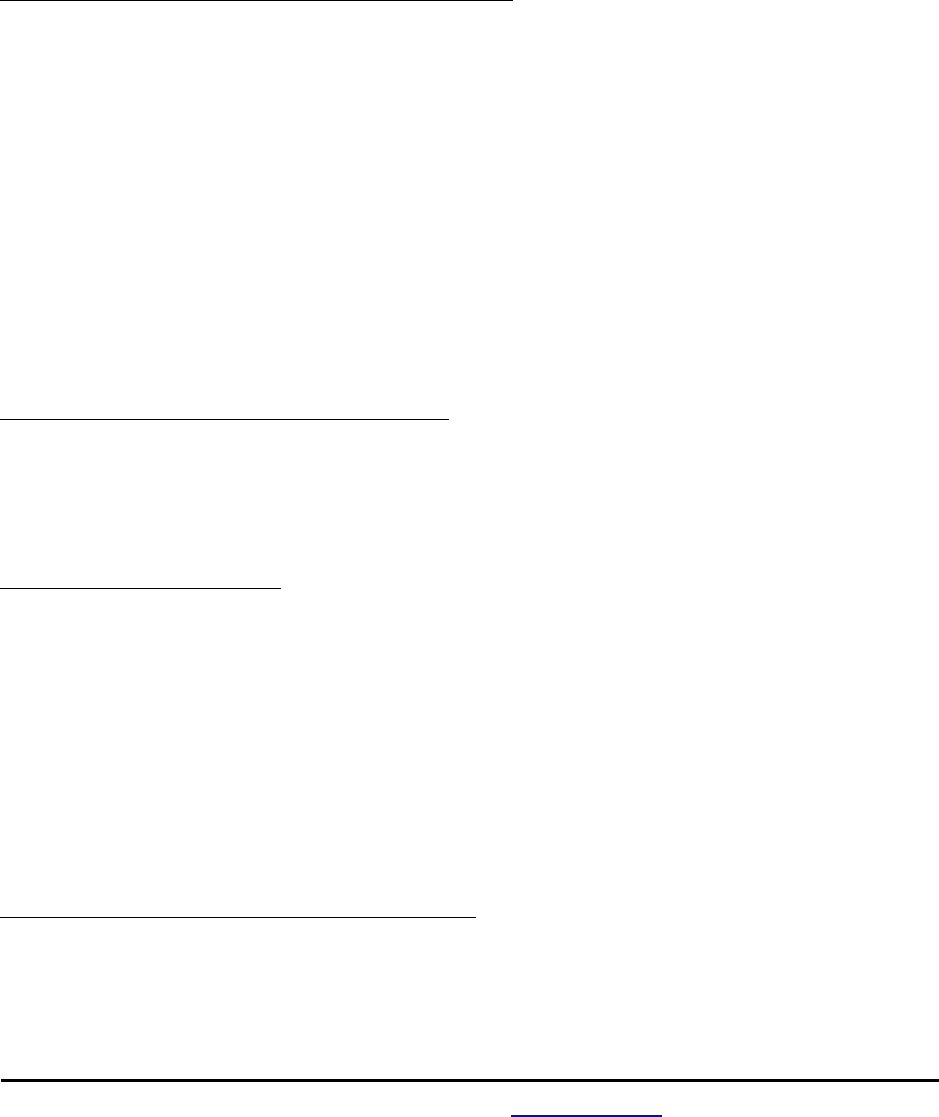
For assistance, call RITRON at 800-872-1872, or go to www.ritron.com 13
AUTOMATIC LOW BATTERY ALERT MESSAGE.....................................................................................................
If the battery voltage drops below approximately 6 Volts, the Quick TalkTM transmits a factory prerecorded message,
“Low Battery”, every 60 minutes. When this occurs, replace the batteries promptly — within a day or so.
CONNECTING AN EXTERNAL +12 VDC POWER SUPPLY......................................................................................
The Quick TalkTM may be used with an external +12 VDC power supply. With an external supply connected the
internal batteries are automatically configured as a back-up power source. With the Quick TalkTM programmed for
External Power and batteries installed as a back-up, it will broadcast the Power Fail message any time the external
supply is removed and will repeat the Power Fail message once every hour until external power is restored.
To use the Quick TalkTM with an external +I2 VDC power supply:
1. Use the PC Programmer to set the Quick TalkTM for External Power.
2. If the factory recorded “Power Fail” message is not adequate, record a new Power Fail message.
3. Use Ritron #RPS-203 Power Supply (11-15 VDC, 200 mA), or equivalent, to power the Quick TalkTM. The Quick
TalkTM requires 11-15 VDC, 200 mA minimum.
4. Connect the positive (+) terminal of the power supply cable to the RED wire on the Quick TalkTM color-coded
cable.
5. Connect the negative (-) terminal of the power supply cable to the BLACK wire on the Quick TalkTM color-coded
cable.
6. Be sure to use an appropriate sized, sealing wire nut to connect the wires. The color-coded wires are 24 AWG
stranded.
SOLAR PANELS FOR OPERATING & CHARGING RECHARGEABLE BATTERIES .......................................................
Quick TalkTM uses little power when it is not transmitting. The estimated time the unit transmits can help determine
the solar panel size required to charge rechargeable batteries. The following formula sizes the solar panel:
The formula to calculate the solar panel’s required mAH:
(TX time per hour) x (TX current in mA) x (Number of hours per day) = Req’d. mAH per day
EXAMPLE: Assume the Quick TalkTM transmits for one minute of every hour, on average (1/60 hour). Further
assume the Quick TalkTM draws 150 mA of current while transmitting (150 mA).
NOTE: 150 mA is a bit higher than real consumption; the panel will be slightly oversized.
Plug the Example into the Formula:
(1/60 hour) x (l50mA) x (24 hours/day) = 60 mAH per day
RESULTS: In this Example, the Quick TalkTM solar panel requires 60 mAH in a 24-hour period.
NOTE: Study solar panel manufacturers’ information. Quick TalkTM input voltage cannot exceed 15 VDC.
ADDING A SECOND SWITCH TO DISABLE THE QUICK TALKTM TRANSMITTER.........................................................
What is the purpose adding a second switch to disable the Quick TalkTM?
There may be times you want the Quick TalkTM to not transmit messages. For example, if Quick TalkTM reports the
status of an entry door for the night shift, you may wish to not hear status messages all day. Use a second switch to
enable the Quick TalkTM at night, and disable it during the day.
To add a second switch to disable Quick TalkTM Messaging:
1. Use the PC Programmer to set the Quick TalkTM for Input 2 On/Off Switch.
2. Connect an external switch to the GRAY and ORANGE wires on the Quick TalkTM color-coded cable for
connection to Input 2.
NOTE: With Input #2 in On/OFF mode, Quick TalkTM functions normally with the external switch closed. When the
switch is open, Quick TalkTM is disabled and will not transmit messages. When the On/Off switch has been open

For assistance, call RITRON at 800-872-1872, or go to www.ritron.com 14
(Quick TalkTM disabled), and it is then closed, Quick TalkTM transmits the prerecorded message describing the current
condition of Input #1.
MONITOR 4-20 MA SENSOR CURRENT LOOP WITH QUICK TALK TM ANALOG INPUT ..............................................
Quick TalkTM can act as a current sink when a resistor is connected between an Input’s positive and negative
connection. The resistance value is selected to scale the current to the permitted 0 - 5 Volt range for the Input to
Quick TalkTM. The following formula is used to calculate the Analog Threshold Setpoints necessary for your
application.
Analog Threshold Setpoint = 4-20 ma current (Amps) times the resistor value (Ohms)
NOTE: A resistor value of 250Ω provides the maximum resolution, and is the recommended value. Using a lower
resistance value with the 4-20 mA current loop produces less than 5 V at the Input and the measurement resolution is
reduced. Using a higher resistance value at 20 mA can produce a voltage greater than 5V at the Input, which will not
be recognized.
To configure an Input for 4-20 mA current loop:
1. Connect a resistor between the two wires on the Quick TalkTM color-coded cable that are associated with the
desired Input (see Table 6)
2. Connect the output of the 4-20 mA current loop device to the positive (+) wire of the Input connection.
3. Program the desired Input for Analog Input operation and for the calculated Analog Setpoints.
4. Record an Input OPEN and Input CLOSED message for the associated Input.

For assistance, call RITRON at 800-872-1872, or go to www.ritron.com 15
RITRON, INC. LIMITED WARRANTY .....................................................................................................................
WHAT THIS WARRANTY COVERS:
RITRON, INC. ("RITRON") provides the following warranty against defects in materials and/or workmanship in RITRON Radios and
Accessories under normal use and service during the applicable warranty period (as stated below). "Accessories" means
antennas, holsters, chargers, earphones, speaker/microphones and items contained in the programming and programming/service
kits.
WHAT IS COVERED FOR HOW LONG WHAT RITRON WILL DO
Ritron RQT Quick TalkTM 1 year* During the first year after date of purchase, RITRON will repair or
replace the defective product, at RITRON's option, parts and labor
included at no charge.
Accessories 90 days* *After date of purchase
WHAT THIS WARRANTY DOES NOT COVER:
• Any technical information provided with the covered product or any other RITRON products;
• Installation, maintenance or service of the product, unless this is covered by a separate written agreement with RITRON;
• Any products not furnished by RITRON which are attached or used with the covered product, or defects or damage from the use
of the covered product with equipment that is not covered (such as defects or damage from the charging or use of batteries other
than with covered product);
• Defects or damage, including broken antennas, resulting from:
- misuse, abuse, improper maintenance, alteration, modification, neglect, accident or act of God,
- the use of covered products other than in normal and customary manner or,
- improper testing or installation;
• Defects or damages from unauthorized disassembly, repair or modification, or where unauthorized disassembly, repair or
modification prevents inspection and testing necessary to validate warranty claims;
• Defects or damages in which the serial number has been removed, altered or defaced.
• Batteries if any of the seals are not intact.
IMPORTANT: This warranty sets forth the full extent of RITRON’s express responsibilities regarding the covered products, and is
given in lieu of all other express warranties. What RITRON has agreed to do above is your sole and exclusive remedy. No person
is authorized to make any other warranty to you on behalf of RITRON. Warranties implied by state law, such as implied warranties
of merchantability and fitness for a particular purpose, are limited to the duration of this limited warranty as it applies to the covered
product. Incidental and consequential damages are not recoverable under this warranty (this includes loss of use or time,
inconvenience, business interruption, commercial loss, lost profits or savings). Some states do not allow the exclusion or limitation
of incidental or consequential damages, or limitation on how long an implied warranty lasts, so the above limitations or exclusions
may not apply to you. Because each covered product system is unique, RITRON disclaims liability for range, coverage, or operation
of the system as a whole under this warranty.
WHO IS COVERED BY THIS WARRANTY: This warranty is given only to the purchaser or lessee of covered products when
acquired for use, not resale. This warranty is not assignable or transferable.
HOW TO GET WARRANTY SERVICE: To receive warranty service, you must deliver or send the defective product, delivery
costs and insurance prepaid, within the applicable warranty period, to RITRON, INC., 505 West Carmel Drive, Carmel, Indiana
46032, Attention: Warranty Department. Please point out the nature of the defect in as much detail as you can. You must retain
your sales or lease receipt (or other written evidence of the date of purchase) and deliver it along with the product. If RITRON
chooses to repair or replace a defective product, RITRON may replace the product or any part or component with reconditioned
product, parts or components. Replacements are covered for the balance of the original applicable warranty period. All replaced
covered products, parts or components become RITRON’s property.
RIGHTS TO SOFTWARE RETAINED : Title and all rights or licenses to patents, copyrights, trademarks and trade secrets in
any RITRON software contained in covered products are and shall remain in RITRON. RITRON nevertheless grants you a limited
non-exclusive, transferable right to use the RITRON software only in conjunction with covered products. No other license or right to
the RITRON software is granted or permitted.
YOUR RIGHTS UNDER STATE LAW: This warranty gives you specific legal rights, and you may also have other rights which
vary from state to state.
WHERE THIS WARRANTY IS VALID: THIS WARRANTY IS VALID ONLY WITHIN THE UNITED STATES, THE DISTRICT
OF COLUMBIA AND PUERTO RICO.

PRELIMINARY
Quick Assist ®
Wireless Callbox Transmitter Owner’s Manual
______________________________________________________________________
Ritron Publication 14500079 Rev. A 12-10
© 2010 Ritron, Inc. All rights reserved. Ritron, Patriot, Jobcom, OutPost, GateGuard, Quiet Call and Quick Assist are registered
trademarks of Ritron, Inc. Quick Talk, Liberty and RadioNexus are trademarks of Ritron, Inc.
Call 800-USA-1-USA for the right Wireless Solutions to your communication needs.
P.O. Box 1998 • Carmel, Indiana 46082-1998 • USA
Phone: 317-846-1201; 800-USA-1-USA (800-972-1872) • Fax: 317-846-4978
Email: ritron@ritron.com
www.ritron.com

For assistance, call RITRON at 800-872-1872, or go to www.ritron.com 0
TABLE OF CONTENTS ...............................................................
Description Page
What this Manual Covers............................................................... ii
Important Safety information.......................................................... ii
Quick Assist® Features Described in this Manual .......................... ii
About the Quick Assist® Wireless Callbox Transmitter
General information....................................................................1
Quick Assist® Models and Frequencies .....................................1
Please Note the Following with Regard to RF Exposure for this
Product ..........................................................................................1
Frequently Asked Questions about Quick Assist® Programming ...2
Installation / Replacement of Batteries...........................................3
Identification of Quick Assist® Controls and Connectors................4
FIG-1: Controls & Connectors...................................................4
Quick Assist® Programming Features............................................5
Description .................................................................................5
Frequency Table ........................................................................5
Transmit Frequency ...................................................................5
QC or DQC Code .......................................................................5
DQC Invert .................................................................................5
TX Alert Tone .............................................................................5
Compand....................................................................................6
Input Operation ..........................................................................6
Reset Operation .........................................................................6
Message Repeat ........................................................................6
Quick Assist® Default Programming...........................................7
Programming Your Quick Assist® Transmitter Frequency and Tone
.......................................................................................................8
Table 1: MURS model radios only..............................................8
Table 2: VHF Business band models ........................................8
Table 3: UHF Business band models........................................8
Table 4: Quiet Call Tone Codes .................................................9
Table 5: Digital Quiet Call Codes ..............................................9
Recording Your Quick Assist® Voice Messages ..........................10
Number of Inputs......................................................................10
Message Delay on TX..............................................................10
Quick Assist® Messages ..........................................................10
Low Battery Message...............................................................10
Power Fail Message.................................................................10
Location Message ....................................................................10
To Record Your Quick Assist® Voice Messages: .....................10
Test Your Quick Assist® Programming ........................................11
Installing the Quick Assist®..........................................................12
Care and Maintenance.................................................................12
Record Custom Voice Messages.................................................13
Setting Battery Saver Options......................................................13
Automatic Low Battery Alert Message .........................................13
Connecting an External +12 VDC Power Supply.........................13
Ritron, Inc. Limited Warranty .......................................................14
WHAT THIS MANUAL COVERS ..................
This manual covers basic operation of the
Quick Assist® Wireless Callbox Transmitter.
For most applications, this is all the
information you will need.
IMPORTANT SAFETY INFORMATION ............
NOTICE: The Quick Assist® unit should not
be used to report conditions relating to safety
of life or property.
To reduce the risk of fire, electric shock or
personal injury, follow these basic safety
instructions when using this unit.
1. Read and follow all instructions.
2. Disconnect the unit before cleaning. Do
not use liquid or aerosol cleaners.
3. Use only approved power sources for
the unit.
4. During thunderstorms, avoid contact
with this unit and any external antenna
system or wiring.
5. If you are unsure whether your
installation will be safe, contact an
experienced electrician or electronics
technician.
QUICK ASSIST® FEATURES DESCRIBED IN
THIS MANUAL ...........................................
• Internal radio transmitter (separate VHF
and UHF models).
• User-recorded voice messages; total
recording time of 24 seconds.
• Typical range of 1/2 mile. Longer range is
possible using an optional antenna.
• Internal battery holder for six (6) AA
Alkaline cells.
• Typical operating battery life of 1 year.
• Automatic low battery message.
• Programmable Features:
- Transmit Frequency;
- Tone Coded Squelch Encoder (Quiet
Call® Interference Eliminator);
- Digital Coded Squelch Encoder
(Digital Quiet CaII® Interference
Eliminator);
- Message transmission schedules and
limits.
• Connection and use of an external 12
Volt DC power supply.
• Limited One-year Factory Warranty.
ii

For assistance, call RITRON at 800-872-1872, or go to www.ritron.com 1
ABOUT THE QUICK ASSIST® WIRELESS CALLBOX TRANSMITTER.........................................................................
General Information
The Quick Assist® is a RITRON Wireless Callbox
Transmitter, specialized for indoor retail or commercial
use, and pre programmed to transmit a custom
recorded “assistance needed” message when the
Message push-button is pressed for customer
assistance. Personnel know from these message
transmissions in which specific areas a customer needs
assistance.
The Quick Assist® is easily programmed to transmit on
either an existing or a new radio frequency, with the
most popular sub-audible coded squelch formats, such
as Quiet Call® or Digital Quiet CaII®. This enables all
your personnel with JOBCOM®, PATRIOT™ or
equivalent two-way radios to hear the voice messages
instantly.
The Quick Assist® can be installed in a wide variety of
indoor locations. Because it’s six internal AA Alkaline
batteries will power the unit for about a year, the Quick
Assist® does not require AC line power.
Quick Assist® Models and Frequencies
There are two Quick Assist® models, one for each of
the most popular professional radio communications
bands. The model number appears on a label on the
bottom of the case, and on a second label inside the
case.
MODEL BAND FREQUENCY RANGE
RQA-151 VHF-FM 150 to 165 MHz
RQA-451 UHF-FM 450 to 470 MHz
Ritron manufactures mobile, portable and base station
two-way radios and repeaters for use with Quick
Assist®. Ritron pioneered the use of Color Dots on
radios to identify frequencies.
Factory-programmed, default Quick Assist® frequencies
are:
Red Dot = 151.625 MHz for VHF units;
Blue Star = 467.925 MHz for UHF units.
See page 4 for instructions on changing the Quick
Assist® transmit frequency to match an existing radio
system.
PLEASE NOTE THE FOLLOWING WITH REGARD TO RF EXPOSURE FOR THIS PRODUCT .........................................
EXPOSURE TO RADIO FREQUENCY ENERGY:
RQA-151: This product generates radio frequency (RF)
energy when the button on the front of the unit is
depressed. This product has been evaluated for
compliance with the maximum permissible exposure
limits for RF energy at the maximum power rating of the
unit when using antennas available from RITRON.
RQT-151: This product generates radio frequency (RF)
energy when the state of any of the four inputs has
been changed. This product has been evaluated for
compliance with the maximum permissible exposure
limits for RF energy at the maximum power rating of the
unit when using antennas available from RITRON.
For both the AFB-1545 and the standard internal
antennas, at the 20 cm (7.9 inches) minimum expected
separation distance and greater, the maximum RF
exposure is well below the General
Population/Uncontrolled limits. Antennas other than
those available from RITRON have not been tested for
compliance and may or may not meet the exposure
limits at the distances given. Higher gain antennas are
capable of generating higher fields in the strongest part
of their field and would, therefore, require a greater
separation from the antenna. This product is not to be
used by the general public in an uncontrolled
environment unless compliance with the
Uncontrolled/General Population limits for RF exposure
can be assured.
To limit exposure to RF energy to levels below the limit,
please observe the following:
• Use only the antenna(s) available from RITRON for
these models. DO NOT operate the radio without
an antenna.
• DO NOT activate the transmitter when not actually
wishing to transmit. These radios transmit recorded
messages of a pre-determined length to prevent
continuous transmit times.
• When transmitting, make certain that the distance
limits for the particular model in use are observed.
• DO NOT allow children to operate the radio.
When used as directed, this series of radios is designed
to comply with the FCC’s RF exposure limits for
“Uncontrolled/General Population”. In addition, they are
designed to comply with the following Standards and
Guidelines:
• United States Federal Communications
Commission, Code of Federal Regulations; 47 CFR
§§ 2 sub-part J.
• American National Standards Institute (ANSI) /
Institute of Electrical and Electronic Engineers
(IEEE) C95. 1-1992.
• Institute of Electrical and Electronic Engineers
(IEEE) C95.1-1999 Edition.
Copyright Telecommunications Industry Association

For assistance, call RITRON at 800-872-1872, or go to www.ritron.com 2
FREQUENTLY ASKED QUESTIONS ABOUT QUICK ASSIST® PROGRAMMING...........................................................
Do I have to program my Quick Assist®?
You may not need to program your Quick Assist® at all. If you
purchased a Quick Assist® unit that is factory programmed to
your radio system frequency (check the frequency on your
radios and the Quick Assist®), and you do not use a form of
Quiet Call coded squelch, you can install the batteries and
start using Quick Assist®. The factory default voice message
is “Assistance Needed”. Otherwise, read this manual before
programming your Quick Assist®.
Do I need to program every feature?
In many cases, no. The factory pre-programmed settings,
explained in the instructions, may meet many of your needs.
How do I program my Quick Assist®?
All programming is accomplished with the RITRON
RQA/RQT PC Programmer software available at
www.ritron.com.
The programmer software requires Window® XP or greater,
and a PC computer with a USB port.
What if I don’t find what I need in this manual?
Call Ritron (317-846-1201): we will be glad to help you. For
most applications, this manual should cover everything you
will need to know. However, the Quick Assist® has more
capabilities and features than described here.
Will it harm the Quick Assist® if I program it improperly?
No; however, you may need to erase all programming and
start over, see page 5 to do this. Feel free to experiment with
the various features and possible configurations.
Can my settings or messages get lost or erased if the
battery runs down, or if my Quick Assist® is
disconnected?
No. The settings and voice messages you enter are stored in
special electronic memory devices in the Quick Assist® that
do not require power to hold the information. This means that
if the batteries run down or if you remove them, you will not
need to reprogram the Quick Assist®. All your settings and
messages will be there for you when you install fresh
batteries.
What if I need more range?
To increase the range of your Quick Assist® transmissions,
we suggest you first relocate the unit. Ritron also
manufactures radio repeaters to increase the range not only
for your Quick Assist®, but also for your entire radio system.
What is my Radio System Frequency?
Ritron pioneered the Color Dot system to simplify the
identification of radio system frequencies for Ritron Jobcom®
radios. Color Dots are placed on the bottoms of and inside
the enclosures of all Jobcom® radios. Other
manufacturers have also adopted this idea.
To identify your assigned frequency if your radios
do not have a color dot, locate a label identifying
the receiver frequency in megahertz (MHz). Your
assigned frequency is also shown on your F.C.C.
Station License. Consult your radio user manual,
your dealer, or call Ritron for help if you cannot
determine your radio’s receiver frequency.
Do I need to program my Quick Assist®
transmitter frequency?
The original factory-programmed transmitter
frequency of your Quick Assist® is marked on the
outside of the shipping box. If the Quick Assist®
frequency matches your radio system frequency,
and if the Quick Assist® has not been
reprogrammed since it left the factory, you will not
have to program the transmitter frequency.
What is Quiet Call® Sub Audible Coded
Squelch?
The Quick Assist® radio transmitter is compatible
with two standard communications industry sub
audible signaling formats: QC (Quiet Call®
Interference Eliminator), and DQC (Digital Quiet
Call® Interference Eliminator). Both Quiet Call®
formats unlock receivers programmed to require
these codes, they screen out interference from
other radio systems operating on your same
frequency.
QC Quiet Call® is Ritron’s trade name for what the
communications industry calls sub-audible (below
the range of human hearing) tone squelch, or
CTCSS (Continuous Tone Coded Subaudible
Squelch) or Interference Eliminator. Other radio
manufacturers use different trade-names for
essentially the same system. You may program a
specific QC code into your Quick Assist® to
transmit with the voice messages, which will
“unlock” the receivers in your radio system.
DQC Digital Quiet Call® is Ritron’s digital coded
squelch, and works the same as QC, except it is a
digital code that is transmitted with the voice
messages.
Do I need to program my Quick Assist® with a
Quiet Call Code?
Your radio system may or may not use coded
squelch signaling. If you have programmed the
Quick Assist® to match your radio frequency, and
your radios are not receiving Quick Assist®
transmissions unless the “monitor” or “test” button
is pressed on your radio, your system is probably
using Coded Squelch. Refer to your radio manual,
or contact your radio dealer or Ritron if you are
unsure about this issue.
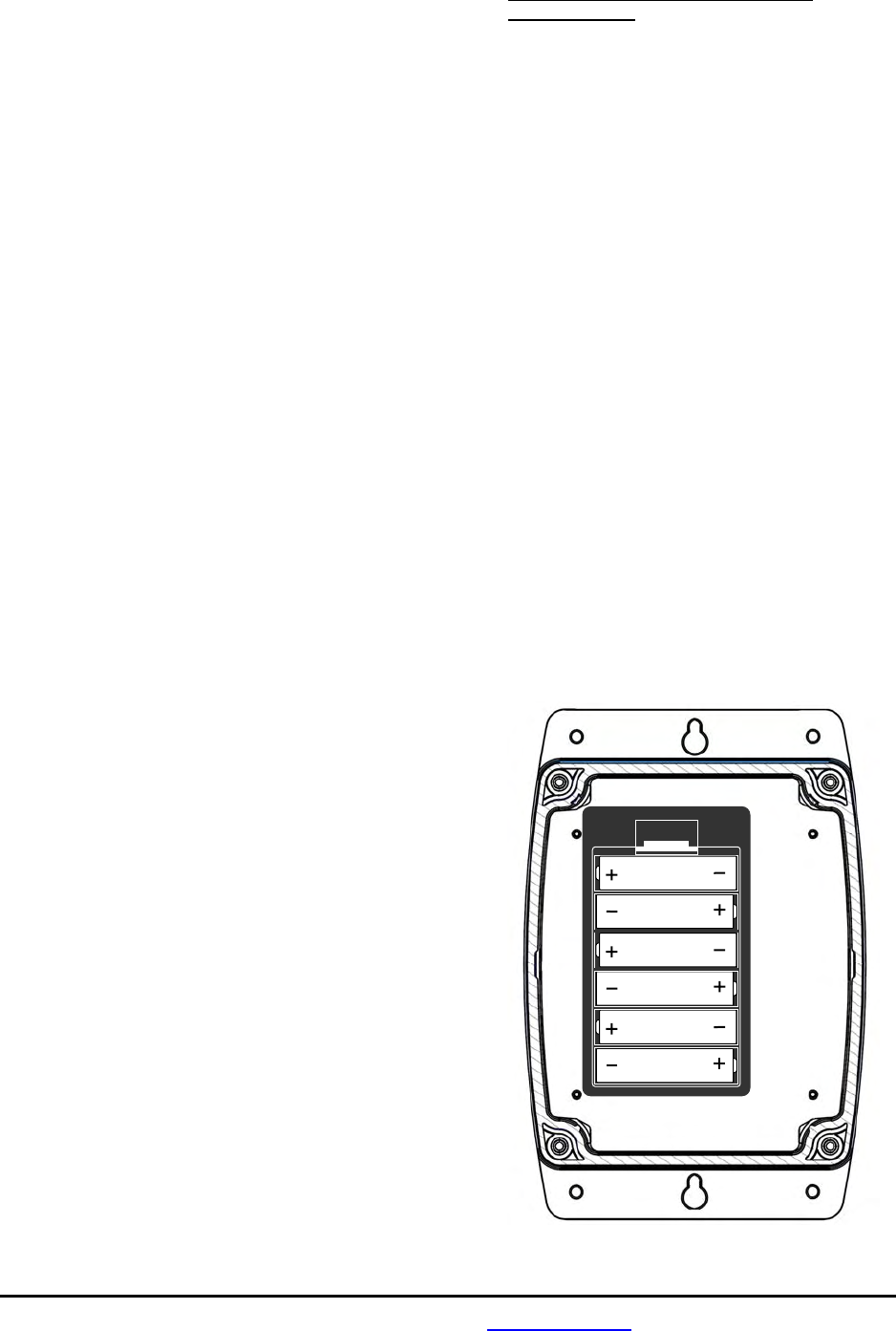
For assistance, call RITRON at 800-872-1872, or go to www.ritron.com 3
If your Quick Assist® was previously programmed with a
Quiet Call® code and you need to remove it, follow the
programming instructions, using No Tone code, “44”, as
shown in the table.
What is Digital Quiet Call®?
Digital Quiet Call® (DQC) is a digital sub-audible coded
squelch system.
Do I need to program my Quick Assist® with a Digital
Quiet Call code?
If your radio system does not use Digital Quiet Call®, or any
other trade name equivalent, you will not need to program a
Digital Quiet Call® code.
What is the purpose of testing the Quick Assist® radio
transmitter?
After programming your radio, your Quick Assist® will
transmit on the same frequency as your radio receivers,
using any coded squelch signals required for your radio
system.
Do I need to test my Quick Assist® Transmitter?
Yes; performing this test now will save you time and
confusion later.
TO TEST THE QUICK ASSIST® RADIO
TRANSMITTER:
a. Turn on your radio receiver.
b. Press the red button on front of the Quick
Assist®.
c. Quick Assist® transmits the “Assistance
needed” message, which you should be able
to hear on your radio receiver.
If you do not hear the messages, you have
probably not properly programmed the Quick
Assist® transmitter frequency or the Quiet Call®
Coded Squelch. In this case, repeat the
programming, then perform this test again.
What is the purpose of recording a unique
Voice Phrase for the Low Battery Message?
When it senses the installed batteries are nearly
run down, Quick Assist® will transmit one time
each hour the factory- programmed message:
“Low Battery”. If you maintain several Quick
Assist® transmitters within radio range of each
other, you may customize this feature to easily
determine which unit needs new batteries.
Do I need to program this feature?
If you use only one Quick Assist® in any area, or if
you regularly change Quick Assist® batteries, the
factory programmed message may be sufficient
for your application.
INSTALLATION / REPLACEMENT OF BATTERIES ...................................................................................................
1. Remove the Quick Assist® from the wall or mounting
surface.
2. Remove the four corner screws holding the case
halves together, located on the back side of the
enclosure.
3. Separate the case halves and disconnect the battery
holder from the radio printed circuit board by
separating the in-line connectors.
4. Remove the lid on the battery holder by pressing the
tab at the top, and then remove the old batteries.
5. Install the new batteries. Be sure to observe the
correct polarity of the batteries, shown in the bottom
of the battery holder.
6. Install the battery holder lid and connect the two
polarized, in-line battery connectors.
7. Press the front panel push button and test the Quick
Assist® by listening on a receiving radio.
8. Secure the case halves with the four corner screws
and re-install on the wall or mounting surface.
NOTE: Be sure to properly dispose of the used batteries
removed from the Quick Assist®.
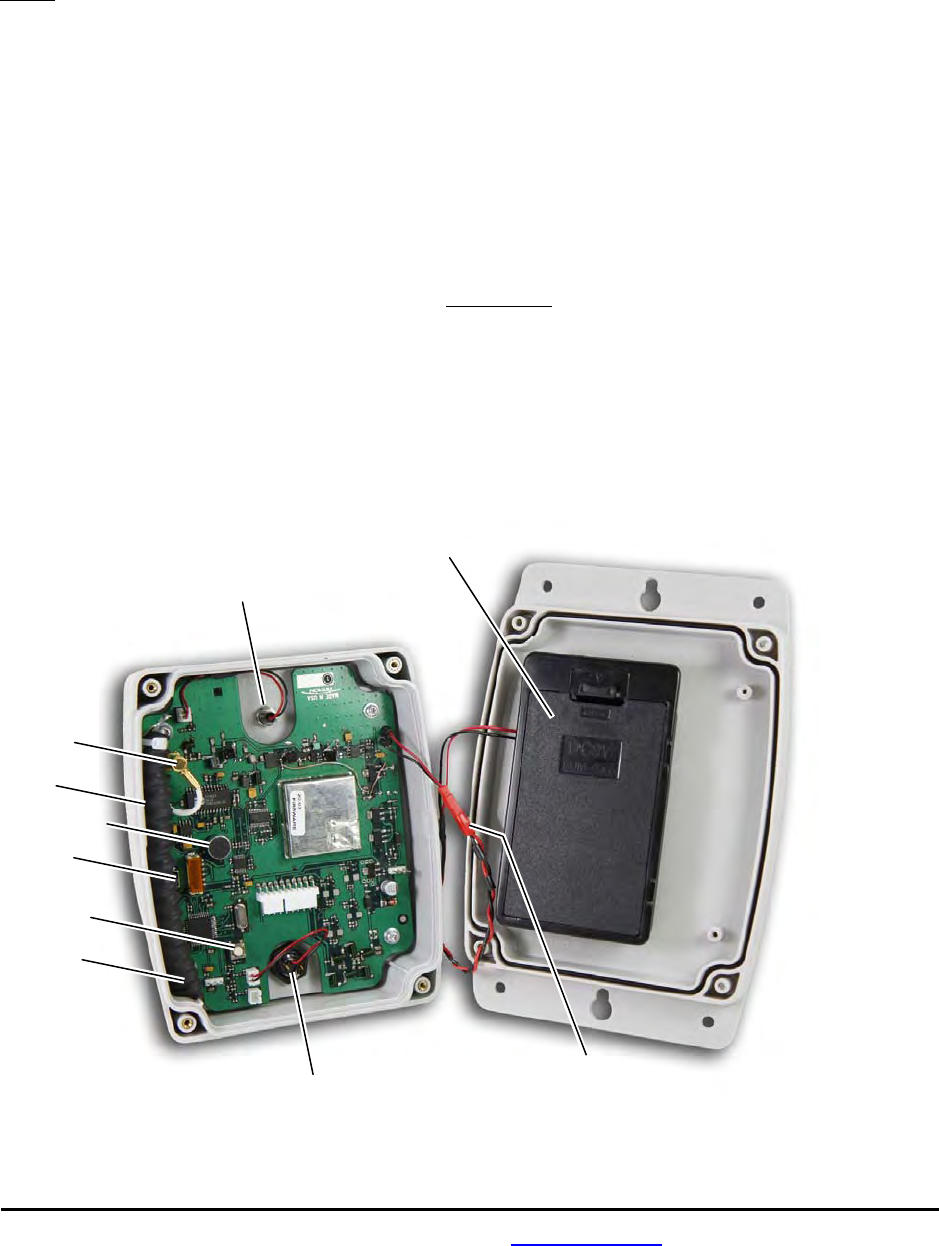
For assistance, call RITRON at 800-872-1872, or go to www.ritron.com 4
1
2
3
4
5
6
9 10
7
8
IDENTIFICATION OF QUICK ASSIST® CONTROLS AND CONNECTIONS ....................................................................
1 Battery Holder
The battery holder accommodates the six (6)
standard “AA” alkaline cells required to power the
Quick Assist®.
NOTE: Always install a fresh set of alkaline
batteries before programming the unit.
2 Front Panel LED
The red front panel LED is lit whenever the Quick
Assist® is transmitting a message.
3 SMB Antenna Connector
This connects the internal antenna to the radio
printed circuit board.
4 External Audio Input
Allows input to the Quick Assist® voice recorder
from an external audio source, such as the Line
Out audio from your computer.
5 Microphone
Microphone for recording voice messages.
6 USB Programming Connector
Connects the Quick Assist® to the USB port on your
computer for programming.
7 Record Button
Press this button to initiate voice recording.
8 Internal Antenna
The internal antenna radiates radio signals.
9 Front Panel Push Button
When the front panel push button is pressed the Quick
Assist® transmits your pre-recorded voice message. This
sealed push button provides a water-resistant enclosure.
10 Battery Connector
In-line connector between the printed circuit board and the
battery holder.
IMPORTANT: Do not remove any other fasteners or further
disassemble the Quick Assist® unit; doing so risks damage to
the unit and voiding the manufacturer’s warranty.
FIG-1: CONTROLS & CONNECTIONS

For assistance, call RITRON at 800-872-1872, or go to www.ritron.com 5
QUICK ASSIST® PROGRAMMABLE FEATURES .....................................................................................................
The Quick Assist® features four (4) separate inputs that can each be
programmed with unique voice messages and attributes. All
programming is accomplished with the RITRON RQA/RQT PC
Programmer software available at www.ritron.com.
The programmer software requires Window® XP or greater, and a PC
computer with a USB port.
Description
Enter a brief description (35 characters or less) of the programming
profile, or of the recorded message. This can be useful when reading
out the Quick Assist® programming at a later date, or when saving a
programming profile for use with other radios.
Frequency Table #
To match other RITRON radios, the owner can select from a table of
transmit frequencies. Simply “read-out” the Frequency Code of your
RITRON portable, mobile or base radio and enter the same code when
programming the Quick Assist®.
Transmit Frequency
Once you have selected a Frequency Code the actually transmit
frequency will appear here. If your operating frequency does not appear
on the Frequency Code list, a licensed radio service technician will be
able enter other frequencies within the radio’s operating band.
To identify your assigned frequency:
• Read-out the Frequency Code of the RITRON radio you intend to
use with the Quick Assist®.
• Check for a corresponding color dot on the radio you intend to use
with the Quick Assist®.
• Locate a label identifying the receiver frequency in megahertz
(MHz).
• Your assigned frequency is shown on your F.C.C. Station License.
• Call your radio dealer or Ritron for help if you cannot determine your
radio’s receiver frequency.
The original factory-programmed
transmitter frequency of your Quick
Assist® is marked on the outside of the
shipping box.
QC or DQC Code
Select from a list of QC and DQC
Codes to transmit subaudible squelch
tones for interference elimination.
The Quick Assist® radio transmitter is
compatible with two standard
communications industry sub-audible
signaling formats: QC (Quiet Call®
Interference Eliminator), and DQC
(Digital Quiet Call® Interference
Eliminator). Both Quiet Call formats
unlock receivers programmed to
require these codes -- they screen out
interference from other radio systems
operating on your same transmit
frequency.
QC Quiet Call® is Ritron’s trade name
for what the communications industry
calls sub-audible (below the range of
human hearing) tone squelch, or
CTCSS (Continuous Tone Coded
Subaudible Squelch). Other radio
manufacturers use different trade-
names for essentially the same system.
You may program a specific QC code
into your Quick Assist® to transmit with
the voice messages, which will “unlock”
the receivers in your radio system.
DQC Digital Quiet Call® is Ritron’s
digital coded squelch, and works the
same as QC, except it is a digital code
that is transmitted with the voice
messages.
To identify your QC or DQC tone:
• Read-out the Tone Code of the
RITRON radio you intend to use
with the Quick Assist®.
• Refer to your radio manual.
• Contact your radio dealer or Ritron
if you are unsure about this issue.
DQC Invert
The DQC Digital Quiet Call® code can
be inverted for systems that required
inversion.
TX Alert Tone
The Quick Assist® can transmit an alert
tone before and after each voice
message transmission.

For assistance, call RITRON at 800-872-1872, or go to www.ritron.com 6
Compand
Some two-way radios have a feature referred to as
“companding”. It is a way of eliminating background
hiss or noise, making the radio sound clearer.
“Companding” is a combination of audio “compression”
in the transmitter and audio “expanding” in the receiver.
The Quick Assist® can be programmed for audio
compression. To determine if your existing 2-way radios
are using the Companding feature, you can check the
radio’s User Manual, contact your radio dealer, or call
Ritron for help.
If you are unable to determine if your portable radio
uses the companding feature, we suggest the following:
1. Leave the radio in the factory default setting with
no companding.
2. Activate the transmitter of the Quick Assist® and
listen to the message from your portable radio. If
the received audio is acceptable, you should not
need to set the Quick Assist® for companding.
Input Operation
Normal – operation transmits a message each time the
front panel push button is pressed.
Debounce Mode - is an option specifying that the front
panel button must remain pressed for the programmed
debounce time before generating a message for the
changed condition.
Example: A Quick Assist® is used to alert store
personnel that assistance is need. If someone were to
repeatedly press and release the button, it would be
considered a single button press.
Holdoff Mode - option transmits a message
immediately after the front panel push button has been
pressed, but will hold off sending additional messages
for the programmed holdoff time.
Example: A Quick Assist® is used to alert store
personnel that assistance is need. It is practical for the
message to be transmitted immediately, and also
desirable to have a one-minute holdoff before the same
message is re-sent, even if the button is pushed again
by an impatient customer.
Debounce / Holdoff Time – specifies the debounce
time or holdoff time described above.
Latching Input Mode -The Quick Assist® is set for
Latching Input mode. The latching effect maintains
message repeats after a momentary switch change has
ended. This is necessary for momentary push button
operation.
Reset Operation
No Reset – operation means that the Quick Assist® will
continue with scheduled transmissions with no ability to
stop them.
Example: You recorded the message “Assistance
needed in the paint department”, and then programmed
Quick Assist® to transmit the message 8 times with 2
minutes between each transmission. With No Reset
programmed the messages will be sent as scheduled
for the full 16 minutes whenever the push button is
pressed.
Reset from Front Panel Button – allows store
personnel to press and hold the front panel button for a
period of time greater than the programmed Reset
Button Hold Time to terminate scheduled transmissions.
Example: A Quick Assist® is used to alert store
personnel that assistance is need in the paint
department. It is practical for an “Assistance needed in
the paint department” message to be transmitted
immediately, and also to be repeated every 30 seconds
until an attendant has responded. The attendant will
then hold down the front panel button until the LED
flashes rapidly to signal that the Quick Assist® has been
reset. A “Paint department has been serviced”
message is then sent to notify other store personnel
that the call has been answered.
2nd Reset Button Installed – operates the same as
Reset from Front Panel Button except a separate,
momentary button is used for reset.
Reset Button Hold Time – specifies the length of time
the reset button must be held down before reset
operation to occur.
Message Repeat
Repeat Message on each transmission
Your recorded voice message can be programmed to
repeat from one time to nine times on each Quick
Assist® radio transmission, depending on how you
program this feature. More urgent messages may have
more phrase repeats.
Example: You recorded the message “Assistance
needed in the paint department”, and then programmed
Quick Assist® to repeat the phrase two (2) times in each
transmission. In this case, activating the switch results
in the Quick Assist® transmitting:
“...beep. Assistance needed in the paint department.
Assistance needed in the paint department. beep...”
The beginning and ending beeps are added
automatically to attract attention to Quick Assist®
transmissions if the TX Alert Tone feature has been set.
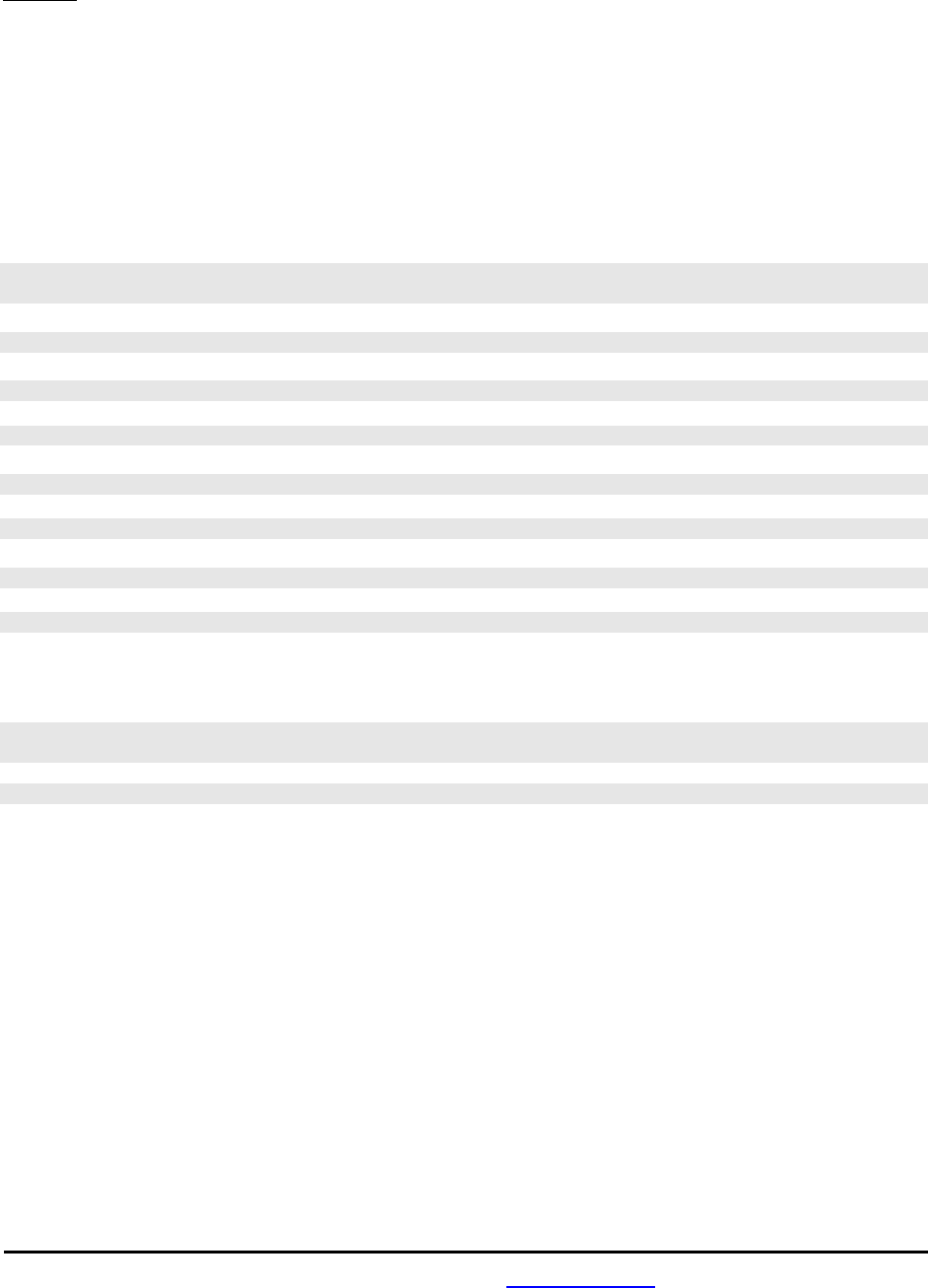
For assistance, call RITRON at 800-872-1872, or go to www.ritron.com 7
Repeat Message with multiple transmissions
You can set a limit to the number of times the message
will be transmitted at the scheduled intervals.
Example: Suppose you have placed a Quick Assist® at
the delivery door of your building. Your recorded
message might then be “Visitor at Delivery Door”. You
may want this message to be transmitted every two
minutes for approximately a quarter hour after the push
button has been pressed, and then to stop transmitting
until the button is pressed again. In this case, you would
program the message Wait Time for every two minutes,
and set the Message Limit to “8”, as described here.
When the push button is pressed the message is
transmitted every 2 minutes until it has been sent 8
times over a span of 16 minutes.
The Quick Assist® is set at the factory to transmit the
recorded message twice with a 30 second Wait Time in
between transmissions.
Wait time between repeated transmissions
This sets the amount of time the Quick Assist® will wait
between repeated transmissions.
QUICK ASSIST® DEFAULT PROGRAMMING ..........................................................................................................
TX Frequency VHF 24 151.625 MHz
UHF 26 467.850 MHz
QC/DQC Code 44 No Tone
DQC Invert No
Compand No
Reset Operation Reset from Front Panel Button
Reset Button Hold Time 5 sec.
Input Operation Normal
Latching Input Mode Yes
Debounce/Holdoff Time 10 sec.
Number of Inputs 1
TX Alert Tone Yes
Battery Saver Yes
Low Battery Message Yes
Power Fail Message No
Message Delay on TX 1 sec.
Recorded Messages RQA Message “Assistance needed”
Reset Message “Call answered”
Power Fail “Power fail”
Low Battery “Low battery”
Number of Times Recorded Message
is repeated on each Transmission 1 time
Number of Times the Transmission is sent 2 times
Wait Time between Transmissions 30 seconds
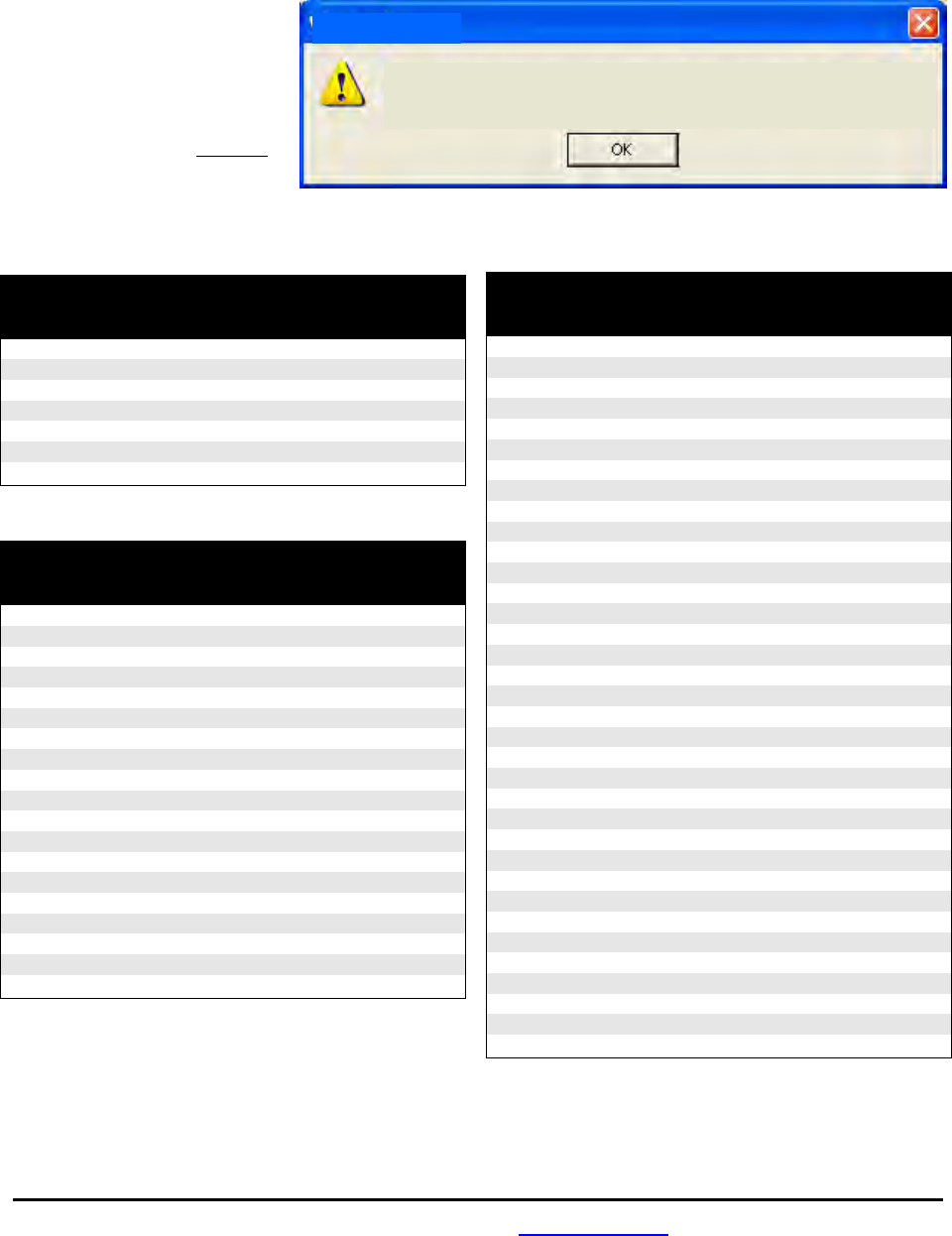
For assistance, call RITRON at 800-872-1872, or go to www.ritron.com 8
PROGRAMMING YOUR QUICK ASSIST® TRANSMITTER FREQUENCY AND TONE .....................................................
The Quick Assist® transmitter operates exclusively on a 12.5 kHz narrow band channel bandwidth. Many of the
Frequency Table Codes programmed in your compatible Ritron radios are for 25 kHz wide band channels. If these
codes are selected when programming your Quick Assist® radio, the programmer will automatically update to the
equivalent 12.5 kHz code. This allows you to use your Quick Assist® with all of your existing radios. The following
dialog box will appear any time you attempt to program a wideband code into a Quick Assist®.
MURS model radios can only be
programmed to the codes listed
on Table 1 below. VHF Business
band models can be programmed
to the codes listed on Table 2
below, or can be programmed to
any valid licensed frequency
between 150-165 MHz EXCEPT
the frequencies listed on MURS
Table 1 below.
TABLE 1: MURS model radios only
Narrow Band
Frequency Equivalent
Code (MHz) Color Dot Code
01 154.600 Green Dot 22
02 154.570 Blue Dot 23
19 151.820 MURS
20 151.880 MURS
21 151.940 MURS
22 154.600 MURS
23 154.570 MURS
TABLE 2: VHF Business band models
Narrow Band
Frequency Equivalent
Code (MHz) Color Dot Code
03 151.625 Red Dot 03N *
04 151.955 Purple Dot 04N *
05 151.925 05N *
06 154.540 06N *
07 154.515 07N *
08 154.655 08N *
09 151.685 09N *
10 151.715 10N *
11 151.775 11N *
12 151.805 12N *
13 151.835 13N *
14 151.895 14N *
15 154.490 15N *
16 151.655 16N *
17 151.745 17N *
18 151.865 18N *
24 154.700
25 151.760
26 152.700
* New Narrow Band Table Frequency
TABLE 3: UHF Business band models
Narrow Band
Frequency Equivalent
Code (MHz) Color Dot Code
01 467.7625 J 24
02 467.8125 K 25
03 464.5500 Yellow Dot 23
04 464.5000 Brown Dot 22
05 467.8500 Silver Star 26
06 467.8750 Gold Star 27
07 467.9000 Red Star 28
08 467.9250 Blue Star 29
09 469.2625 09N *
10 462.5750 White Dot 10N *
11 462.6250 Black Dot 11N *
12 462.6750 Orange Dot 12N *
13 464.3250 13N *
14 464.8250 14N *
15 469.5000 15N *
16 469.5500 16N *
17 463.2625 17N *
18 464.9125 18N *
19 464.6000 19N *
20 464.7000 20N *
21 462.7250 21N *
22 464.5000
23 464.5500
24 467.7625
25 467.8125
26 467.8500
27 467.8750
28 467.9000
29 467.9250
30 461.0375
31 461.0625
32 461.0875
33 461.1125
34 461.1375
35 461.1625
The frequency code you have selected is for 25 kHz wideband operation.
The Quick Assist radio operates on 12.5 kHz narrow band only. Your
frequency code will be automatically updated to a narrow band equivalent.
IMPORTANT!

For assistance, call RITRON at 800-872-1872, or go to www.ritron.com 9
TABLE 3: UHF Business band models (cont.)
Narrow Band
Frequency Equivalent
Code (MHz) Color Dot Code
36 461.1875
37 461.2125
38 461.2375
39 461.2625
40 461.2875
41 461.3125
42 461.3375
43 461.3625
44 462.7625
45 462.7875
46 462.8125
47 462.8375
48 462.8625
49 462.8875
50 462.9125
51 464.4875
52 464.5125
53 464.5375
54 464.5625
55 466.0375
56 466.0625
Narrow Band
Frequency Equivalent
Code (MHz) Color Dot Code
57 466.0875
58 466.1125
59 466.1375
60 466.1625
61 466.1875
62 466.2125
63 466.2375
64 466.2625
65 466.2875
66 466.3125
67 466.3375
68 466.3625
69 467.7875
70 467.8375
71 467.8625
72 467.8875
73 467.9125
74 469.4875
75 469.5125
76 469.5375
77 469.5625
TABLE 4: Quiet Call Tone Codes
Code Frequency
01 67.0
02 71.9
03 74.4
04 77.0
05 79.7
06 82.5
07 85.4
08 88.5
09 91.5
10 94.8
11 97.4
12 100.0
13 103.5
Code Frequency
14 107.2
15 110.9
16 114.8
17 118.8
18 123.0
19 127.3
20 131.8
21 136.5
22 141.3
23 146.2
24 151.4
25 156.7
26 162.2
Code Frequency
27 167.9
28 173.8
29 179.9
30 186.2
31 192.8
32 203.5
33 210.7
34 218.1
35 225.7
36 233.6
37 241.8
38 250.3
39 69.4
Code Frequency
40 159.8
41 165.5
42 171.3
43 177.3
44 No Tone
45 183.5
46 189.9
47 196.6
48 199.5
49 206.5
50 229.1
51 254.1
Use Code “44” to program No Tone for systems without a Coded Squelch Interference Eliminator feature.
TABLE 5: Digital Quiet Call Codes
Code
023
025
026
031
032
036
043
047
051
053
054
065
Code
071
072
073
074
114
115
116
122
125
131
132
134
Code
143
145
152
155
156
162
165
172
174
205
212
223
Code
225
226
243
244
245
246
251
252
255
261
263
265
Code
266
271
274
306
311
315
325
331
332
343
346
351
Code
356
364
365
371
411
412
413
423
431
432
445
446
Code
452
454
455
462
464
465
466
503
506
516
523
532
Code
546
565
606
662
612
624
627
631
632
645
654
664
Code
703
712
723
731
732
734
743
754
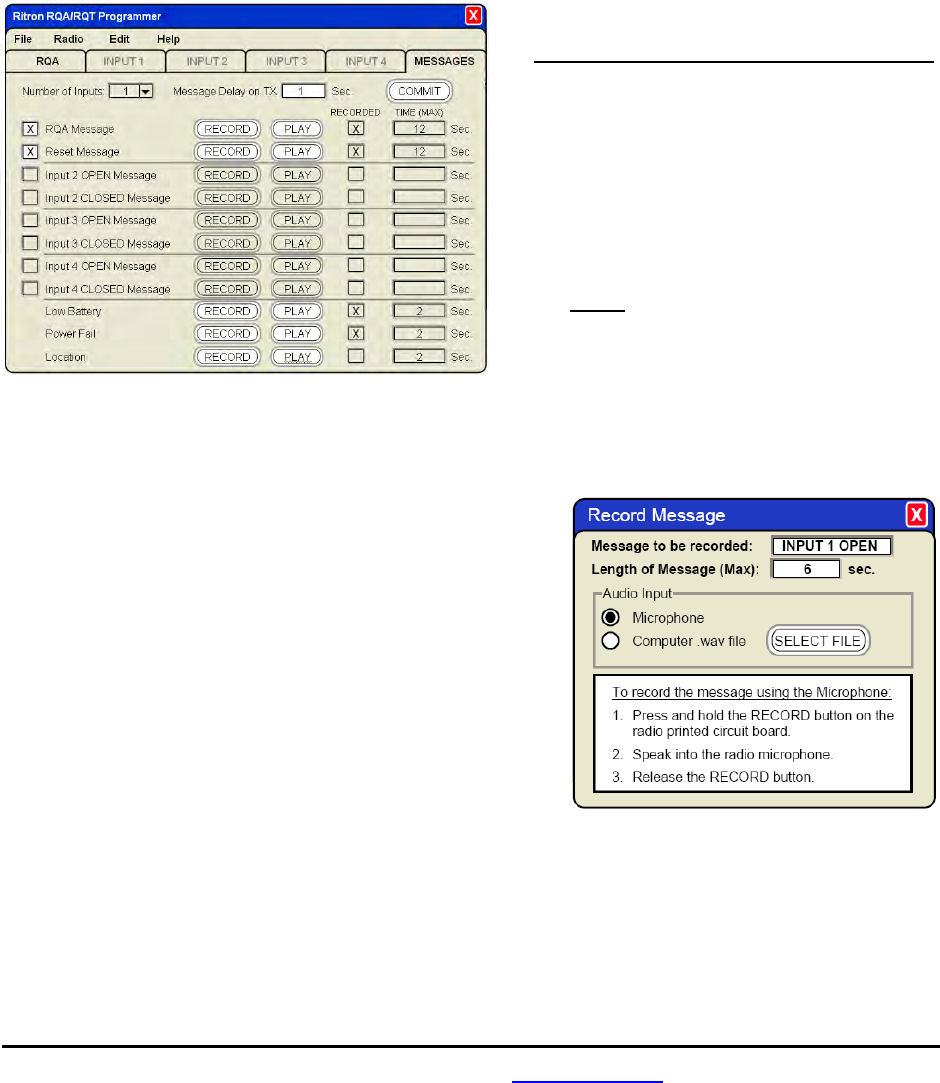
For assistance, call RITRON at 800-872-1872, or go to www.ritron.com 10
RECORDING YOUR QUICK ASSIST® VOICE MESSAGES ........................................................................................
The Quick Assist® can be programmed to play two unique
voice messages, an “Assistance needed” message that is
transmitted when the front panel push button is pressed, and
a “Call answered” message that is transmitted if the Quick
Assist® has been reset.
Voice messages can be recorded into the Quick Assist®
using the RQA/RQT PC Programmer and the electret
condenser microphone built onto the radio PCB assembly.
Voice messages can also be recorded with an incoming
audio signal from you computer. This allows you to record
and store a message onto your computer and use it for
multiple Quick Assist® transmitters.
Number of Inputs
The number of inputs is fixed at 1 for Quick Assist®.
Message Delay on TX
Whenever the Quick Assist® transmitter is activated it will
wait this length of time before the alert tones and recorded
voice message are sent.
Quick Assist® Messages
A total of 24 seconds is allocated for Quick Assist® voice
messages, 12 seconds for the RQA Message and 12
seconds for the Reset Message.
Low Battery Message
When it senses the installed batteries are nearly run down,
Quick Assist® will transmit one time each hour the factory-
programmed message: “Low Battery”. If you maintain
several Quick Assist® transmitters within radio range of each
other, you may customize this feature to easily determine
which unit needs new batteries.
If you use only one Quick Assist® in any area, or if you
regularly change Quick Assist® batteries, the factory-
programmed message may be sufficient for your application.
Power Fail Message
When the Quick Assist® is powered with an
external +12VDC supply and batteries are
installed as a back-up, the RQA will transmit the
Power Fail Message on a scheduled basis as long
as the +12VDC external supply is not detected.
Location Message
When installing more than one Quick Assist® on a
single frequency it may be desirable to record a
unique Location Message to identify each
individual Quick Assist®. The Location Message
will be played after the TX Alert Tone and before
the RQA Message.
To record your Quick Assist® Voice Messages:
1. Read existing radio programming.
2. Enter the Number of Inputs you will be using.
3. Select the messages you will be recording.
4. Enter Message Delay on TX time.
5. If there were any changes made during steps
2 through 4, press the COMMIT button. This
will erase all input messages, they will have to
be re-recorded and the RECORDED boxes
will no longer be checked.
NOTE: Pressing COMMIT button will not
erase the Low Battery, Power Fail, or
Location messages.
6. To record a new message, press the desired
RECORD button and follow the instructions
on the Record Message dialog box.
7. The RECORDED checkbox will now indicate
that the message is recorded.
After you have recorded the message you can
review by pressing the associated PLAY button.
The Quick Assist® will transmit the message on
the transmit frequency associated with the input
selected.

For assistance, call RITRON at 800-872-1872, or go to www.ritron.com 11
TEST YOUR QUICK ASSIST® PROGRAMMING.......................................................................................................
Once your Quick Assist® has been programmed it will transmit on the same frequency as your radio receivers, and
will transmit any coded squelch signals required for your radio system. Before installing the Quick Assist® you
should test for communication with your radio receivers.
To test the Quick Assist® radio transmitter:
1. Turn on your radio receiver.
2. Press the front panel push button switch.
3. Quick Assist® will transmit the RQA “Assistance needed” message, which you should be able to hear on your
radio receiver.
4. Press and hold the front panel push button switch until the front panel LED blinks rapidly.
5. Quick Assist® will transmit the Reset “Call answered” message, which you should be able to hear on your radio
receiver.
6. If you do not hear the messages, you have probably not properly programmed the Quick Assist® transmitter
frequency or the Quiet Call® Coded Squelch. In this case, repeat the programming and perform this test again.
Depending upon your programming, the following sequence describes what you should hear with your radio receiver:
1. The RQA transmitter is activated on the Transmit Frequency and QC or DQC Code programmed when the front
panel push button is pressed and released.
2. The RQA will broadcast silence for the programmed Message Delay on TX Time
3. The RQA will broadcast the TX Alert Tone if it has been programmed.
4. The RQA will broadcast the Location Message if it has been recorded.
5. The RQA will broadcast the recorded RQA Message.
6. The RQA Message will be repeated for the number of times programmed for Repeat Message on each
Transmission.
7. The RQA will broadcast the TX Alert Tone again to signal the end of message, if it has been programmed.
8. The RQA transmitter will turn OFF and the RQA will wait for the period of time programmed for Wait Time
between Transmissions.
9. If Repeat Message Transmissions has been programmed for more than one transmission, the RQA transmitter
will again be activated and Steps 1 – 8 will be repeated for the programmed number of transmissions.
10. If at any time during this sequence the front panel button is held down until the LED begins flashing rapidly, the
RQA will transmit the Reset Message and the sequence will be terminated.
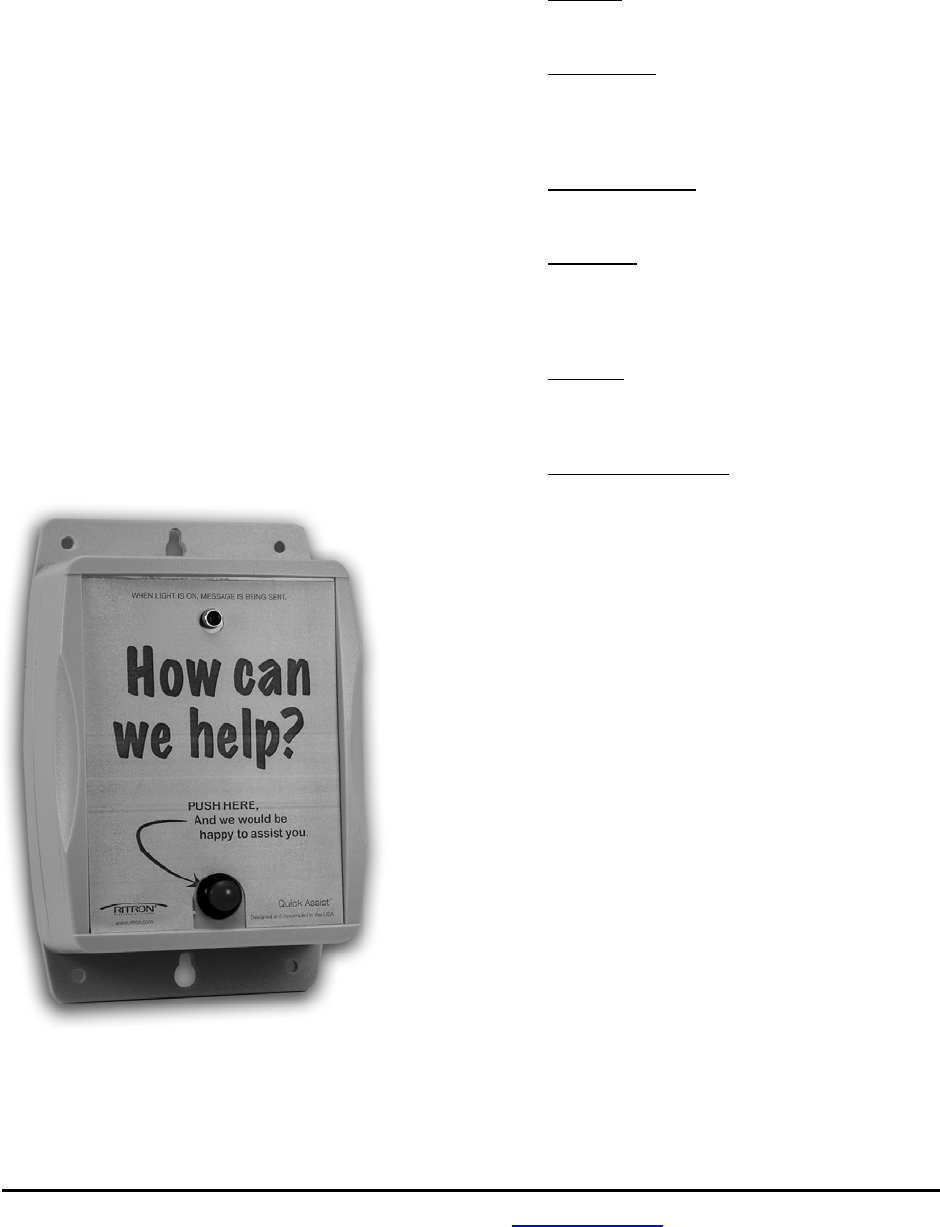
For assistance, call RITRON at 800-872-1872, or go to www.ritron.com 12
INSTALLING THE QUICK ASSIST®........................................................................................................................
Prior to installing the Quick Assist® transmitter, it is important to verify all radio programming to be certain that you
have achieved the operation you desire. Re-programming requires the removal of the Quick Assist® from its installed
location, which can be time consuming and frustrating.
1. Install 6 new AA Alkaline batteries into the
internal battery holder and screw the case halves
together. Be sure the case halves are pulled tightly
together for a good weather seal.
2. Select a location that provides the best possible
radio coverage.
• Avoid mounting to metal structures
• Install as high as possible
• Be sure the Quick Assist® is in a vertical position
• Be aware that metal or wires near the Quick
Assist® can block or absorb radio transmissions.
3. Temporarily mount the Quick Assist® using the
top keyhole slots.
4. Test the radio from this location to be sure you
get the necessary radio coverage. This is
achieved by pressing the front panel push button on
the Quick Assist® while a second radio-equipped
person receives the transmission at the furthest point
you will need to cover.
5. Permanently mount the Quick Assist® using either
the four (4) corner mounts, or the top and bottom
keyhole slots.
CARE AND MAINTENANCE...............................
Moisture: The Quick Assist® is highly weather-
resistant in outdoor environments. Do not
immerse the unit in water.
Temperature: The Quick Assist® is designed to
operate between -22 and +140 degrees
Fahrenheit. Like all electronic equipment, Quick
Assist® should not be subjected to extreme heat.
A shaded area is an ideal outdoor location.
VibrationslShocks: Though the Quick Assist® is
designed to be rugged, it cannot be expected to
survive extreme abuse.
Chemicals: Do not use harsh, corrosive or
abrasive chemicals to clean the Quick Assist®
case; use only a cloth moistened with water. Do
not attempt to clean the printed circuit board
inside the housing.
Batteries: Use only fresh, new alkaline batteries
when programming Quick Assist®. Acceptable
brands and types are: Duracell MX1500B,
Eveready E91, Rayovac 815 or equivalent.
Estimated Battery Life: Starting with a fresh set
of AA alkaline batteries, Quick Assist® can
transmit about 7,000 voice messages over a
period of one year before the batteries will need
to be replaced.

For assistance, call RITRON at 800-872-1872, or go to www.ritron.com 13
RECORDING CUSTOM VOICE MESSAGES ............................................................................................................
What is the purpose of Recording Custom Voice Messages?
Recording customized Quick Assist® voice messages gives them unmistakable meaning and significance. The
standard factory prerecorded messages of “Assistance needed” and “Call answered” require the listener to know
exactly where the Quick Assist® is located. However, when a user hears a custom message such as ‘Assistance
needed in the paint department”, the meaning is clear.
Do I need to record Custom Voice Messages?
If the factory-recorded messages “Assistance needed” and “Call answered” suit your application, recording custom
messages is not necessary.
To record a custom message, follow the instructions in the Recording Your Quick Assist® Voice Messages section of
this manual. Once recorded, playback the message to be sure you are satisfied with the quality and content of the
message.
Setting Battery Saver Options.....................................................................................................................
The Battery Saver factory default is “Battery Saver enabled.” With this setting the Quick Assist® only checks the push
button switch 4 times a second to extend battery life. To detect very fast changes, disable the Battery Saver option.
When the Battery Saver Option is disabled, it is recommended that Quick Assist® is powered with an external power
supply. This is because it draws approximately 7 mA continuously with this setting and will rapidly drain the batteries.
NOTE: DO NOT disable the Battery Saver unless you need to detect very fast changes on the inputs.
AUTOMATIC LOW BATTERY ALERT MESSAGE.....................................................................................................
If the battery voltage drops below approximately 6 Volts, the Quick Assist® transmits a factory prerecorded message,
“Low Battery”, every 60 minutes. When this occurs, replace the batteries promptly — within a day or so.
CONNECTING AN EXTERNAL +12 VDC POWER SUPPLY......................................................................................
The Quick Assist® may be used with an external +12 VDC power supply. With an external supply connected the
internal batteries are automatically configured as a back-up power source. With the Quick Assist® programmed for
External Power and batteries installed as a back-up, it will broadcast the Power Fail message any time the external
supply is removed and will repeat the Power Fail message once every hour until external power is restored.
To use the Quick Assist® with an external +I2 VDC power supply:
1. Use the PC Programmer to set the Quick Assist® for External Power.
2. If the factory recorded “Power Fail” message is not adequate, record a new Power Fail message.
3. Use Ritron #RPS-203 Power Supply (11-15 VDC, 200 mA), or equivalent, to power the Quick Assist®. The Quick
Assist® requires 11-15 VDC, 200 mA minimum.
4. Connect the positive (+) terminal of the power supply cable to the RED wire on the Quick Assist® color-coded
cable.
5. Connect the negative (-) terminal of the power supply cable to the BLACK wire on the Quick Assist® color-coded
cable.
6. Be sure to use an appropriate sized, sealing wire nut to connect the wires. The color-coded wires are 24 AWG
stranded.

For assistance, call RITRON at 800-872-1872, or go to www.ritron.com 14
RITRON, INC. LIMITED WARRANTY .....................................................................................................................
WHAT THIS WARRANTY COVERS:
RITRON, INC. ("RITRON") provides the following warranty against defects in materials and/or workmanship in RITRON Radios and
Accessories under normal use and service during the applicable warranty period (as stated below). "Accessories" means
antennas, holsters, chargers, earphones, speaker/microphones and items contained in the programming and programming/service
kits.
WHAT IS COVERED FOR HOW LONG WHAT RITRON WILL DO
Ritron RQA Quick Assist 1 year* During the first year after date of purchase, RITRON will repair or
replace the defective product, at RITRON's option, parts and labor
included at no charge.
Accessories 90 days* *After date of purchase
WHAT THIS WARRANTY DOES NOT COVER:
• Any technical information provided with the covered product or any other RITRON products;
• Installation, maintenance or service of the product, unless this is covered by a separate written agreement with RITRON;
• Any products not furnished by RITRON which are attached or used with the covered product, or defects or damage from the use
of the covered product with equipment that is not covered (such as defects or damage from the charging or use of batteries other
than with covered product);
• Defects or damage, including broken antennas, resulting from:
- misuse, abuse, improper maintenance, alteration, modification, neglect, accident or act of God,
- the use of covered products other than in normal and customary manner or,
- improper testing or installation;
• Defects or damages from unauthorized disassembly, repair or modification, or where unauthorized disassembly, repair or
modification prevents inspection and testing necessary to validate warranty claims;
• Defects or damages in which the serial number has been removed, altered or defaced.
• Batteries if any of the seals are not intact.
IMPORTANT: This warranty sets forth the full extent of RITRON’s express responsibilities regarding the covered products, and is
given in lieu of all other express warranties. What RITRON has agreed to do above is your sole and exclusive remedy. No person
is authorized to make any other warranty to you on behalf of RITRON. Warranties implied by state law, such as implied warranties
of merchantability and fitness for a particular purpose, are limited to the duration of this limited warranty as it applies to the covered
product. Incidental and consequential damages are not recoverable under this warranty (this includes loss of use or time,
inconvenience, business interruption, commercial loss, lost profits or savings). Some states do not allow the exclusion or limitation
of incidental or consequential damages, or limitation on how long an implied warranty lasts, so the above limitations or exclusions
may not apply to you. Because each covered product system is unique, RITRON disclaims liability for range, coverage, or operation
of the system as a whole under this warranty.
WHO IS COVERED BY THIS WARRANTY: This warranty is given only to the purchaser or lessee of covered products when
acquired for use, not resale. This warranty is not assignable or transferable.
HOW TO GET WARRANTY SERVICE: To receive warranty service, you must deliver or send the defective product, delivery
costs and insurance prepaid, within the applicable warranty period, to RITRON, INC., 505 West Carmel Drive, Carmel, Indiana
46032, Attention: Warranty Department. Please point out the nature of the defect in as much detail as you can. You must retain
your sales or lease receipt (or other written evidence of the date of purchase) and deliver it along with the product. If RITRON
chooses to repair or replace a defective product, RITRON may replace the product or any part or component with reconditioned
product, parts or components. Replacements are covered for the balance of the original applicable warranty period. All replaced
covered products, parts or components become RITRON’s property.
RIGHTS TO SOFTWARE RETAINED : Title and all rights or licenses to patents, copyrights, trademarks and trade secrets in
any RITRON software contained in covered products are and shall remain in RITRON. RITRON nevertheless grants you a limited
non-exclusive, transferable right to use the RITRON software only in conjunction with covered products. No other license or right to
the RITRON software is granted or permitted.
YOUR RIGHTS UNDER STATE LAW: This warranty gives you specific legal rights, and you may also have other rights which
vary from state to state.
WHERE THIS WARRANTY IS VALID: THIS WARRANTY IS VALID ONLY WITHIN THE UNITED STATES, THE DISTRICT
OF COLUMBIA AND PUERTO RICO.